|
Friday, June 12, 2009
THE GRUB REPORT: Friday Night Mega-Bite: ThaiTable.com
If you liked the flavors featured in this week's Ingredient of the Week recipe, you'll find plenty more inspiration at this week's featured Web site: http://www.thaitable.com/. Recipes featured one day this week included the classic stir-fry pad thai, an asian twist on a Southern U.S. favorite, crispy fried okra (grajiab tod) and the classic Thai dessert mango sticky rice (kow neuw mamuang). The recipes include pictures of various steps and are clear and easy to follow.
There's even a section for beginners near the top of the home page -- "Getting Started?" -- that links to pages exploring the basic Thai tastes and ingredients. There's plenty more to peruse on the site too, to learn more about the Thai culture, along with travel tips, if traveling with your tastebuds doesn't suffice! Originally posted to The Grub Report by Patricia Gibson on Friday, April 3, 2009 1:10 AM EDT Labels: food, grubreport, mega-bite
>>> READ MORE ... you know you want to.
posted by Tricia at
|
 

THE GRUB REPORT: Ingredient of the week: Lemongrass
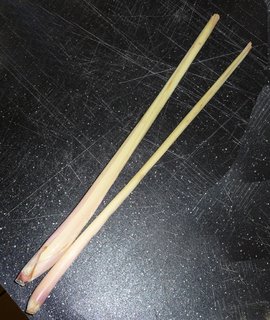
I admit it. We're in a rut. Despite our best intentions, we eat out way too often. When you're crunched for time on a lunch or dinner break, it's tough to find the oomph it takes to make a meal at home. Not to mention that our oven/microwave combo has been out of commission for weeks. (Between ordering parts and scheduling appointments, the repair process has taken way too long. But we're hoping to be back in the baking business next week.)
Even without an oven, though, there's one particular category of food that is usually fairly simple to make on a weekend, with enough leftovers to last a few hectic weekdays: soup.
I love soup. I crave soup. And it's just not the type of thing that most restaurants do well. So a couple weeks ago, a trip to a supermarket in a neighboring county inspired us to cook up our own take on a Thai classic, Tom Ka Gai.
There were plenty of exciting things in the produce section that day. Parsley root. (What would that add to a braise or stew?) Purple carrots. (So familiar, yet so strange. Do they taste different than the orange ones?) Green and orange and purple cauliflower. (Roasted? Pureed? Curried, even?) But it was the lemongrass that we decided to bring home that day.
I've had Tom Ka Gai in a few different Thai restaurants, and I have to admit that they've been a little too heavy on the lemongrass for my taste. The woody stalk's distinctive tang quite easily crosses the line into overpowering. So we weren't exactly going for authentic. We focused on the main flavors -- coconut and lemongrass -- and built from there.
You might find recipes for this type of soup that call for plenty of exotic ingredients. Kaffir lime leaves. Special chilies or chili paste. Galangal. If you're going for authentic, there are Asian markets in bigger cities where you could probably track down such things, not to mention online shops.
But we were going for Thai-inspired flavor in a simple weekend soup. So besides the lemongrass, and the few drops of fish sauce we added (which you could get by without), everything in this recipe is quite easily obtainable here at our local groceries. We decided to add wonderful, meaty shitake mushrooms for a little more substance (which, I learned from online research, is similar to a common Thai variation, Tom Ka Het).
And the result was delicious. It balanced just between light and heavy, refreshing and creamy, bracing and comforting. The lemongrass flavor was there, but not overpowering.
So the next time you see lemongrass -- and who knows, it might be sooner than you think, with a new grocery opening here in our city this spring -- consider trying your hand at this Thai-inspired dish. We steamed up some basmati rice to pair with it, and I loved the two combined into one bowl, too.
Coconut, Lemongrass and Shitake Soup Ingredients 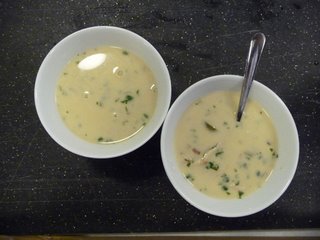
2 cups canned low-salt chicken broth
1 14-ounce can unsweetened coconut milk
1/2 cup 1/4-inch-thick slices fresh lemongrass (at least two stalks)
Several chicken tenders, pounded thinner with a mallet and cut into pieces
1 tablespoon lime juice or more to taste
Soy sauce and fish sauce to taste (or, alternately, salt to taste)
Half a jalapeno chili (or whole one, if you like), chopped
1 package shitake mushrooms, sliced
Finely chopped fresh cilantro
Directions
Bring first 3 ingredients to boil in heavy medium saucepan. (If desired, you can place the lemongrass slices into a tea ball or tie it in cheesecloth before adding it to the liquid. It's simply used to flavor the soup; you don’t want to eat it, and putting it in some sort of straining device like the options mentioned above makes it far more simple to fish it out of the liquid.)
Reduce heat, add chicken and simmer until cooked through.
Remove the chicken to a plate. (You can add it back in later or save it for a different dish, like we did.) You can also remove the lemongrass at this point, or you can leave it in a little longer to impart a more of its flavor to the soup. (Even if you leave it in longer, the flavor's pretty mild. The amount used in this recipe is less than is used in a more authentic preparation, I suspect.)
In a small bowl, mix together lime juice and soy sauce and fish sauce, if using. (If you don’t use either of these sauces, you'll need to add salt to taste.)
Add juice and sauces, along with jalapeno and shitakes to soup, and simmer until reduced, about 20 minutes.
Remove lemongrass, if you haven't already done so.
If desired, add chicken back to liquid to reheat.
Adjust seasoning, adding more salt or soy/fish sauce or more lime juice, if desired.
Ladle soup into bowls, and sprinkle each serving with fresh cilantro (or stir the cilantro into the pot just before serving.)
Serve with rice as a side, or ladle soup over it. Another good garnish is Sriracha chili sauce, if you want to kick up the heat. (Just don't forget, a little goes a long way!)
Originally posted to The Grub Report by By Patricia Gibson on Monday, March 30, 2009 11:06 PM EDT Labels: food, grubreport, recipes
>>> READ MORE ... you know you want to.
posted by Tricia at
|
 

THE GRUB REPORT: Friday Night Mega-Bite: Baking Bites
I'm getting back into this regular blogging thing rather slowly, I know. Forgive me. But I have found another interesting food blog to feature this week in the Friday Night Mega-Bite: Baking Bites. One recent post centers around a Consumer Reports review of frozen pies. (I know what you're thinking: "Gasp! Frozen pies? I would never serve frozen pies!" Well, I would. Don't get me wrong. Homemade pies are scrumptious and can be fabulously impressive. But sometimes, especially around the holidays, a full homemade menu just gets too overwhelming. And in times like those, this review would come in pretty handy!)
The featured pies were key lime and dutch apple. Marie Callender brand came out on top in both categories. But I do have to say, if I were going to serve a frozen pie, it wouldn't be apple. Apple pies are so simple to make! Especially if you use a storebought crust. (I know, I know, homemade's better.) And a streusel topping is pretty basic, too. My preferred frozen pies? Wick's. Perhaps Consumer Reports hasn't heard of this regional favorite. But their sugar cream pies are to die for. (A coworker recently was telling me how a family member's version was far superior. But then we both agreed that the recipe is so touchy, that when you're in a pinch or in a rush, Wick's -- which is based in Winchester, Ind., by the way! -- can't be beat.) They also make a pretty tasty pecan pie, although variations like bourbon pecan pie or chocolate pecan pie can be pretty amazing and worth making at home. What are your favorite holiday pies? Have any recipes you'd like to share? Perhaps in coming weeks we'll share some of our favorites. I'm already excited for all the holiday goodness! Originally posted to The Grub Report by Patricia Gibson on Published: Friday, November 7, 2008 1:14 AM EST
Labels: food, grubreport, mega-bite
>>> READ MORE ... you know you want to.
posted by Tricia at
|
 

THE GRUB REPORT: Friday Night Mega-Bite: Rock 'n Rolling Pins
Hello, Grub Report readers!Long time no write. It's been a crazy year. I know you all know what I'm talking about. Without further ado, here's this week's featured food-related Web site: Rock 'n Rolling Pins.
It's a food blog, too. The author incorporates her love of music and food. Recent posts have posed questions like ... Can fondant be punk rock? Ms. Sassafras, as the author calls herself, also declared Halloween "the raddest holiday in existence." The site's quite a fun read, and there are some great, fun ideas for cupcakes and more. So if you're looking for food with attitude, check out Rock 'n Rolling Pins. Originally posted by Patricia Gibson to The Grub Report on Monday, November 3, 2008 11:27 PM EST Labels: food, grubreport, mega-bite
>>> READ MORE ... you know you want to.
posted by Tricia at
|
 

THE GRUB REPORT: A new rhubarb treat

I had rhubarb left over from my recent pie escapade, so I rummaged through my cookbooks to find something new to try.
I decided to go with a concoction from The Gourmet Cookbook .
I won't reprint the recipe here, because this is a modern cookbook that is still in print (and one that I highly recommend adding to your library).
But I thought I'd tell you about it and share a picture.
It's a twist on the classic upside-down cake, which I'd only ever had made with pineapple. This one features rhubarb in the topping and anise in the batter. Turns out that rhubarb sings when used in this way. It's sweetness really comes out, and along with the sugar, just on the verge of burnt, it creates a melt-in-your-mouth layer with wonderful flavor.
The cake itself is rather remarkable too. The batter was wonderfully silky and it baked up into a dense but not heavy cake that would easily rival any boxed white cake mix (most of which would be too fluffy for this, anyway.)I do have to say I think if I made it again I'd go a little heavier on the anise seed, because I didn't get much of that flavor. But overall I'd say this is definitely a treat I'll make again.
Originally posted to The Grub Report by Patricia Gibson on Wednesday, October 29, 2008 6:45 PM EDT
Labels: food, grubreport
>>> READ MORE ... you know you want to.
posted by Tricia at
|
 

THE GRUB REPORT: Ingredient of the Week: Rhubarb
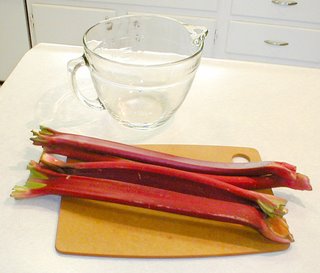 About a month ago, at the June First Friday festival in downtown Marion, a spring specialty caught my eye at the produce stand. I couldn't pass up the chance to take some of the big, bright red stalks home with me. As I walked back to the office, more than one person among the crowds took notice. As I passed, I heard one or two say, "Oooh, rhubarb!"
Once I got back to work, though, the response wasn’t quite the same. "What," a coworker asked curiously, "is that?!?" She'd never heard of rhubarb. "Preposterous!" I thought. Surely rhubarb, the stuff we found growing in the backyard when my family moved to Yorktown when I was young, wasn't that unpopular. But once challenged to explain what, exactly, it is, I realized that there's nothing quite like it, nothing I could compare it to.
It looks like giant Swiss chard, with texture a little like celery and a taste like, well, like … Like nothing else! The astringent tang. The faintly fruity flavor (even though it is, technically, a vegetable). And the leaves are poisonous, by the way! But this description just doesn't do this wonderfully strange plant justice.
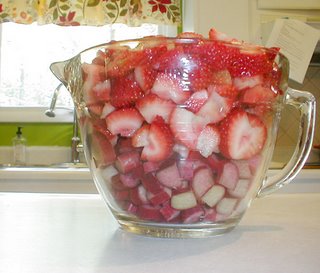
So I did a little poking around online to find out more about it. (I even found a rhubarb festival in a town that calls itself the rhubarb capital of Minnesota!) Turns out this vegetable grows from spring to fall in cooler climates. But it doesn't grow well once temperatures reach 90 degrees, so around here it's pretty much a spring and early summer crop. But it does require cold temperatures to spur it into sprouting, so it doesn't grow well in the South, either. And, according to http://www.rhubarbinfo.com/, a plant will only grow for so many years before it just dies out. That's what happened to that old plant in my parents' backyard. All these quirks together have given it the reputation now of being somewhat an old-fashioned exotic, I think.
Well, I say that's a shame. I'm going to lead the charge. I'm going to try my hand at growing rhubarb, and I urge you to too. According to what I found on the Internet, it's a fairly tough plant that can survive neglect. (Something those plants in my parents' backyard, the only plants still there when we moved in, were proof of.) So let's bring back into our regular rotation of treats.
Here's a recipe to help you do that. It features the classic combination of strawberry and rhubarb. 
Strawberry Rhubarb Pie
Crust (for one 2-crust pie)
2 2/3 cups all purpose flour
2 tablespoons sugar
1 teaspoon salt
12 tablespoons (1 1/2 sticks) chilled unsalted butter, cut into 1/2-inch pieces
4 tablespoons chilled solid vegetable shortening, cut into ½-inch pieces
6 tablespoons (or more) ice water
Filling
1/2 cup sugar
1/2 cup golden brown sugar
1/4 cup cornstarch
1 teaspoon grated lemon rind
1/8 teaspoon ground nutmeg
Pinch of salt
2 1/2 to 3 1/2 cups sliced fresh strawberries (about 16 oz.)
2 1/2 to 3 1/2 cups fresh (1/4-inch-thick) rhubarb slices (1 1/2 pounds or more)
2 tablespoons fresh lemon juice (or less if you want your pie on the sweet end of the sweet-tart flavor combo)
1-2 tablespoons butter or margarine, cut into pieces
Make crust:
Mix flour, sugar and salt for crust in food processor or stir well.
Add butter and shortening. Using on/off turns with processor, or by hand with pastry blender, mix until mixture resembles coarse meal.
Drizzle 6 tablespoons ice water over mixture. Process or mix just until moist clumps form, adding more ice water by teaspoonfuls if dough is dry.
Gather dough into ball; divide and flatten each half into a disk. Wrap in plastic; chill until dough is firm enough to roll out, about 30 minutes.
Roll out half of dough on lightly floured work surface to 12-inch round (about 1/8 inch thick).
Transfer dough to 9-inch-diameter pie dish. Trim excess dough, leaving ¾-inch overhang. Chill, covered, until ready to use, up to 2 days.
Prepare filling:
Preheat oven to 400 degrees.
Combine first 5 ingredients; stir in strawberries, rhubarb, lemon juice and pinch of salt. Let stand 20 minutes.
Compose pie:
Meanwhile, roll out second half of dough to about a 13-inch round, about 1/8-inch thickness, and cut into 1/2-inch strips for lattice top.
Spoon mixture into crust and dot with 1 to 2 tablespoons of butter.
Arrange strips in lattice pattern on top of pie (five to seven strips one way, five to seven the other, basketweave pattern if desired), trim ends if needed, then fold under edges and crimp decoratively.
If desired, brush crust with egg/water wash or with water and sprinkle with coarse sugar.
Bake:
Place pie plate on baking sheet (lined with foil if desired) to catch drips.
Bake at 400 degrees for 20 minutes, reduce heat to 350 degrees and bake until pie is golden and filling thickens about 1 hour and 25 minutes.
Transfer pie to cooling rack and cool completely.
Originally posted to The Grub Report by Patricia Gibson on Wednesday, October 29, 2008 6:45 PM EDT Labels: food, grubreport, recipes
>>> READ MORE ... you know you want to.
posted by Tricia at
|
 

THE GRUB REPORT: Grow your own
I'm a firm believer in the idea that eating more foods grown close to home can have a positive environmental effect.
(Surely the reduction in shipping-related pollution would be exponential if everyone bought only a little more of the fruits and vegetables they ate were produced by area farmers and gardeners.)
I have yet to find a farmers' market here that offers much in the way of good or interesting produce from the local area, though. The closest market I know of that I've been impressed with is in Muncie, at the Minnetrista Cultural Center. But the nature of a farmers' market -- that you have to get there quite early in the morning to get the best stuff -- pretty much precludes me from making it there more than once a year or so. My mom shops there often, though, and sometimes picks things up that she thinks I might be interested in. (If you know of any good markets in the region, let us know!)
I also am fond of the idea of growing my own food. My grandfather was a prolific gardener. It seemed that anything he touched grew wild and produced amazing fruits and vegetables. It's a trait one of my uncles, especially, seems to have inherited. But it's a trait I seem to have pretty much missed out on.
I've tried various types of tomatoes. Chile peppers. Stuff that's supposed to be fairly easy to grow. But I get nothing. (I understand I probably just have a lot to learn. But I've come to be dubious of investing in plants only to get nothing in return.)
One thing that produces immediate results, though, is herb plants. That's what I find myself buying year after year. There's no waiting months for them to flower, then produce fruit or vegetables. There's really very little work involved, actually, with herb plants. The leaves and stems themselves are the prize. The day you bring them home, you can snip pieces off and add them to your plate.
We're trying to stretch our budget, just like everyone else these days, so this year I brought home a trio of my favorites. I might buy more as the season progresses, but for now, I stuck with what I know I'll use:
Cilantro. This is a staple in Asian and Mexican foods. You can usually get it at local groceries, and even when I grow my own I sometimes have to supplement with store-bought if I need a large quantity. But the spicy, clean flavor is one of my favorites (and smells great!), so I buy this every year.
Tarragon. This herb with long, slender leaves is a recently discovered favorite of mine. The taste is vaguely licorice-like. One of my favorite things to do with tarragon is mix it with butter and seasonings to serve with charcoal-grilled steak. Summer at its finest!
Flat-leaf parsley. I like to buy this herb plant because you often can't get the flat-leaf variety of parsley in local groceries. I don't much care for the grassy flavor or inexplicably dry texture of the more common curly variety. But the flat-leaf is a quite different experience. It's fresh, sometimes faintly spicy, and it adds a unique taste to dishes.
And so far this year, we're growing one more edible plant this year: horseradish. A friend passed along the leafy top from one of their home-grown horseradish roots, and it's now
happily rooting at our house. Steve was given the advice, upon receiving the gift, that when it comes time to use it, it's best to prepare it outside because it's so potent! Can't wait to see how it turns out. (And it seems very easy to propagate, which is a huge plus in my book!)
Are you growing anything interesting in the garden or containers this year? We'd love to hear about it. Share your experiences in the comment section below.
Originally posted to The Grub Report by Patricia Gibson on Wednesday, October 29, 2008 4:30 PM EDT
Labels: food, grubreport
>>> READ MORE ... you know you want to.
posted by Tricia at
|
 

THE GRUB REPORT: Cooking the Books: The Gourmet Cookbook
My name is Tricia, and I'm a magazine addict.
I admit it.
I have to keep a pretty tight rein on my urge to subscribe, so I have pretty high standards there. A publication has to wow me every time if I'm going to lock myself in.
But during a trip to the bookstore -- or even down the grocery checkout aisle -- the temptation can be just to much to resist.
Beautiful covers on home-, food- and lifestyle-centric magazines can pull me in almost every time. But once I get them home, and excitedly peruse the contents within, I'm often with left with unfulfilled expectations.
That's where this week's book comes in.
The Gourmet Cookbook , as I mentioned in last week's Ingredient of the Week post, was a gift from Steve's mom.
It's not likely that I would have picked this one up off the shelf -- I'm usually more intrigued by a region- or cuisine-based recipe collection -- but I'm so glad she did.
This book is everything good about Gourmet magazine. It is a collection of what the editors considered the best of the best, culled from years of recipes that have run in the magazine. So, unlike a single magazine, which can build my expecations up and then leave me disappointed when the featured recipes don't quite measure up, there's enough in the book to intrigue and delight me for years to come.
And the almost academic flair Gourmet magazine brings to its study of food and culture is here in the book too: From advice on throwing the perfect cocktail party to a discussion of the provenance of various ingredients, there's plenty of fodder for all-around food fans like me.
And it is, true to the magazine's asthetics, a beautifully designed book. I don't know that I've seen a single-color scheme utilized quite so well in quite a while. And the fact that the color is yellow is all the more impressive. This is one of those cookbooks that I occassionally just sit down to read, to admire, to let it inspire me.
I'll be trying out a recipe for some sweet or another soon. (I promised a coworker I'd bring in some tasty treats.)
And the Parsnip Apple Puree was a hit for Thanksgiving.
Can't wait to try more!
(And next time I'm tempted to buy a magazine, maybe I'll just pull out this book instead.)
Originally posted to The Grub Report by Patricia Gibson on December 10, 2007 12:21 PM
Labels: food, grubreport
>>> READ MORE ... you know you want to.
posted by Tricia at
|
 

THE GRUB REPORT: Friday Night Mega-Bites: Foodpairing
Getting out the door quietly should be the easiest part of my morning routine, but my complete lack of fashion sense causes me to fail this objective time and again. Because I have next to zero confidence in my wardrobe decisions, I constantly have to stir my snoozing spouse to weigh in on such perplexing quandaries as, "Can I wear this belt with these socks?" or, "Is it okay to wear a striped shirt with this sweater?" I'm sure it's aggravating, but I have a perpetual fear of arriving at work in a mismatched ensemble that'd make Emmett Kelly blush.
It's not that I'm incapable of dressing myself. I'm not a 30-year-old in desperate need of over-sized Garanimals. It's just that I'm not always confident in my ability to pair individual pieces together to make a cohesive "outfit."
Creating one new thing from a collection of smaller pieces can be a pretty daunting task, and it is with this in mind that I present this week's Mega-Bite, Foodpairing, a site designed to help make sense of the endless combinations that stare back at you each time you open the refrigerator door.
The site essentially plots food items in a web based upon the number of shared flavor compounds. The shorter the strands between items, the closer the flavor profiles of the foods.
For example, if you click on a relatively innocuous foodstuff such as roasted chicken, you are presented with an additional thirty items that exist within the same general area of the flavor spectrum. Sure the obvious choices (broccoli and potatoes) are there, but more interesting are the seemingly "out there" combos that pop up. I mean, I've never had roasted chicken with chocolate or black tea, but now my mind is working overtime devising different ways to combine them.
Make no mistake. This site is not a recipe site. It's not the place to turn if you're looking for a quick recipe to get on the table in an hour. Instead, this is one for the culinary Miles Davises out there. It's for those willing to improvise in the kitchen and push the boundaries and expectations of the audience. Foodpairings gives you a key signature, a context to work within, and it is up to you to bring the style and artistry to the table.
The Web site: Foodpairing
Originally posted to The Grub Report by Steve Gibson on November 30, 2007 11:22 PM
Comments
At December 1, 2007 9:35 PM, Bill Lewis said...
Steve, the eternal question has always been what to do with leftovers? After spending time in France I'll admit to a certain French bias in my cooking. (Most of my cookbooks are pre- "nouvelle cuisine" French). Their historic solution to leftovers is to include them in either an omelette or crepe. (Legend states the reason for the invention of the crepe was to accommodate leftovers).
Obviously some leftovers, for example, mashed potatoes or parsnips, would not be suitable. However, many seafood, poultry or vegetable dishes would make an excellent filling.
Leftover mashed potatoes can be made into "potato pancakes". They are referred to as "latke" in certain parts of the US and Europe. Usually you form the remaining potatoes into patties and fry/sautee them in oil/butter.Delicious!!
At December 1, 2007 10:42 PM, Bill Lewis said...
Personal note: I'm aware that foodpairing, and my comments concerning leftovers, may not be exactly "on track". But I think the foodpairing procedure is very relevant for determining what to do with leftovers.
At December 4, 2007 5:55 PM, Shannon White said...
I'll be sure and check out your socks tomorow at work — When in doubt, "brown is the new black, you can wear white any time, and if you can see your panty line ... they're too tight".
At December 5, 2007 11:24 PM, Steve Gibson said...
Bill, with just Tricia and I in our household reappropriating leftovers is the MOST important application of food pairing for us. It's what keeps me from having to eat the exact same thing for multiple meals over multiple days.
The omelette is indeed my go to player a lot of the times, but now you have me itching to break out the ole' crepe pan and get busy. If only I could keep from slathering them with Nutella and scarfing them down while standing over the burner I'd be in business!
Labels: food, grubreport, mega-bite
>>> READ MORE ... you know you want to.
posted by Tricia at
|
 

THE GRUB REPORT: Ingredient of the Week: Parsnips
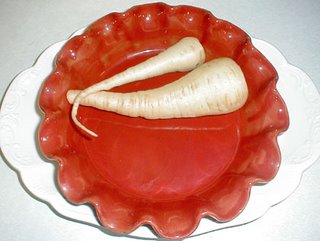
This week's ingredient could be in the running for one of the most underappreciated items in the produce section.
Like their cousin the carrot, parsnips shine in both sweet and savory settings. They certainly are one of things that have quite a strong fall feel, but they can be a year-round addition to the table.
When the fall and winter holidays roll around, however, I'm always reminded of my love for parsnips. The pale, sweetly earthy root veggies always seem to pop up on my Thanksgiving menus.
This year they were showcased quite beautifully in a recipe I found in a cookbook that was gift last year from Steve's mom, The Gourmet Cookbook : Parsnip Apple Puree. It was a perfect pairing with the turkey. Don't mind the gravy, just pile on the parsnips, please! : Parsnip Apple Puree. It was a perfect pairing with the turkey. Don't mind the gravy, just pile on the parsnips, please!
But the best way I can think of to introduce the parsnip to those unfamiliar with its distinctive flavor is as a twist on that old staple carrot salad.
According to epicurious.com, we have the Moroccans to thank for putting this dish on the map.
But my favorite incarnation is what's sometimes billed as Southern-style. It can incorporate just about any add-in that strikes your fancy (or whatever you have on your shelves). The foundation is, quite simply, carrots and a mayonnaise-based dressing.
Here are the basic proportions, but you can vary it to suit your preferences.
Carrot-Parsnip Salad
Ingredients
1 pound carrots, peeled and shredded or grated
1/2 pound parsnips, peeled and shredded or grated
3/4 cup or more of add-ins (see list of suggestions below)
1/2 cup mayonnaise
1 tablespoon Miracle Whip, or to taste (Note: If you don't have Miracle Whip, use granulated sugar to taste. You want the dressing to have a tinge of sweetness.)
salt and pepper to taste
Instructions
Mix carrots, parsnips and your add-ins together.
In a separate bowl, mix mayonnaise, Miracle Whip (or sugar) and salt and pepper together until well blended.
Fold dressing mixture into carrot mixture. If mixture is too dry or too wet, adjust proportions accordingly. (Add more mayo if it's too dry, more carrots if it's too wet. But remember, if you let the mixture set, it will get more soggy.) Then you're ready to serve.
Add-in ideas
-- The standby is raisins, and they're perfectly tasty. But you can also try golden raisins or some of the more "gourmet" raisin mixtures out today.
-- Other dried fruits, such as apricots or dates or even pineapple, chopped into small bite-sized pieces. (Canned pineapple can also be nice. Just make sure you drain it well and chop it up.)
-- Nuts, such as pecans, walnuts or pistachios.
-- Dried shredded coconut.
And we'd love to hear of any other combos you come up with!
Originally posted to The Grub Report by Patricia Gibson on November 28, 2007 11:33 PM
Comments
At November 30, 2007 12:40 AM, James Cramer said...
When I was traveling in France it seemed like pureed parsnip was served with just about every lamb or beef dish I ordered. Just sitting there like a soggy pool of wet mashed potatoes. I did start to kind of like it as a condiment for the meat, sort of like a creamy horseradish. But I never did develop a full appreciation for the carrot's poorer cousin.
At December 4, 2007 2:27 PM, marti mckelleb said...
My experience with growing my own parsnips is that the soil is most important. We raised the pale yellow parsnips in the '70s, and they tasted as though you had soaked them in honey. Yummy. So perhaps the European soil is depleted. I did rather like the parsnips I had in Budapest. And also the rutabagas.
Labels: food, grubreport, recipes
>>> READ MORE ... you know you want to.
posted by Tricia at
|
 

THE GRUB REPORT: Cooking the Books: Rice Cooking
 In other parts of the world, rice is a diet mainstay. I think I could certainly be happy with that kind of diet. I love the stuff. And I'm not talking the over-dressed, over-salted stuff you find on the grocery stores, presented by friendly faces with names like Uncle Ben. I'm talking about freshly steamed, fragrant, snowy mounds of the stuff. And that's why I picked this week's cookbook — Rice Cooking by Robin Howe — from the shelf at an antique store or flea market I've since forgotten. As I flipped through this cookbook (published in 1959, by the way), I lamented the fact that the author repeatedly shielded her readers from authentic, adventurous fare with the reasoning that her contemporaries didn't have the necessary ingredients easily accessible. Howe was obviously well-traveled and in this book gives glimpses into the wonders of food in various parts of the world, but she stops short (understandably so) of giving recipes for such dishes. It made me grateful, however, for the variety of foods we can find even here in Grant County in this modern age. So, much of the book's recipes seem to fall flat. The section on sweet dishes, however, offers intriguing possibilities. I'm a huge fan of rice pudding. I have been ever since I can remember. So it's been fun in recent years as my culinary horizons expanded to discover that many cultures have versions of this dish. And Howe includes many of these traditional dishes, along with some that seem less traditional to me, but sound delicious nonetheless. A couple I'll be trying: -- Rice and Lemon Meringue Pudding: Inspired by the pie, certainly, with a toasty meringue topping and everything. -- Rice and Date Layer Pudding: Billed as an Iraqi dish. I love dates, and this dish's casserole-like construction intrigues me too. And one more recipe that snagged my attention: Rice Waffles. Howe lists this as an American invention, though I have never heard of such a thing. (Have you?) I can't quite envision the final product of this recipe, which incorporates cooked rice into a waffle batter. I'll just have to try it sometime when I have leftover rice! A side note on rice:Another kitchen appliance we didn't know we couldn't live without came into our kitchen as a gift: Our electric rice steamer. This nifty machine actually sat in our cabinet for months before we used it for the first time. How hard is to cook rice, right? But once we tried it, we haven't looked back. You just add the rice and water, according to the machine's measurements, and you turn it on. Then, you're free to continue prepping the rest of your meal, since you don't have to watch this pot. In a while, you'll hear a happy "ding!" and your rice will be ready and fabulous. Another side note on rice:The type and quality of rice does matter. There's short grain (like arborio, the kind used for Italian risotto), long grain (like basmati, the fragrant beauty from India) and others in between. You often can't find much variety here, so I confess that when we go out of town, we buy big burlap bags of the more exotic varieties, especially basmati. Our message, though, would be this: Don't be afraid to try new types of rice when you find them. You can certainly find information about the different types and their uses on the Web, along with suggestions for cooking. Don't let unfamiliarity prevent you from finding a new favorite!
Originally posted to The Grub Report by Patricia Gibson on November 26, 2007 10:37 PM
Comments At November 28, 2007 11:22 AM, Angie said... I purchased a microwave rice cooker earlier this year... we love rice, and though I was skeptical at first, I love this little contraption! (Our electric rice cooker was having some problems, and I ALWAYS boil it over on the stove.) Go rice - and microwaves! Labels: food, grubreport
>>> READ MORE ... you know you want to.
posted by Tricia at
|
 

THE GRUB REPORT: Out of candy corn? Make your own!
For me, the days and even weeks following Halloween are a series of sweet surprises, each one striped in orange, yellow and white. Yup, candy corn is probably the most iconic of autumnal treats, and for the three weeks before and after October 31st it's hard to get away from (not that you'd want to). Yes, like freeloading grains of sand after a beach bash, candy corn have a habit of popping up in the most unlikely of places and well after the party's over. Don't get me wrong. I love it. That last sweet morsel desperately clinging to the bottom of your plastic jack-o-lantern? That errant wedge hiding behind the coasters? They're all fair game, and each one provides a small, unexpected bit of pleasure in the ever-shortening days of November. But, as we all know, even the simplest pleasures cannot last forever. Sadly, by the time you realize that you've discovered and devoured the last of the hidden booty, it becomes next to impossible to buy more. The gargantuan packages that were so abundant on store shelves just a month before have gone the way of the dodo, and you're left wishing you had savored that last piece to its fullest. It's a nagging feeling that can leave you empty for a full 12 months. With this in mind, I thought I'd link to a recipe for homemade candy corn so that others might not have to endure this pain. But first, couple of caveats before you attempt this recipe:
To achieve a flavor closer to that of traditional candy corn, I might suggest cutting the corn syrup in half and replacing it with 1/3 cup of honey. Also, to achieve the classic three-stripe look, wait until your dough has come together, divide it into three equal portions and knead the food coloring into the dough. Roll the portions into individual ropes and flatten with your rolling pin. Finally, don't panic if you taste them right away and they're a bit off. Give them time to sit. I'm convinced that one of the primary agents in flavoring the candy corn we know and love is time. You know they've had plenty of time to sit and develop their flavors on the shelf — maybe since last Halloween! You can find the recipe here. Originally posted to The Grub Report by Steve Gibson on November 1, 2007 12:33 PM
Labels: food, grubreport, recipes
>>> READ MORE ... you know you want to.
posted by Tricia at
|
 

THE GRUB REPORT: Pantry raid
We're always looking for something new to try, so when we come across an appealing idea or recipe, we'll tuck it away for a weekend, when we often spend a little extra time cooking together. Last Sunday, though, was an end to a long week, so we were both thinking pizza. (I wanted takeout, Steve was thinking frozen.) But then we remembered we had some homemade tomato sauce in the freezer, from a summer surplus of tomatoes in a family member's garden. And that got us to thinking. Why buy a pizza when we could just throw together our own? At first I lamented that ingredients would likely cost us more than buying a frozen pizza, but the more we thought about ingredients we had on hand already, the more I liked the idea. We had the sauce. We had ricotta (which I've already established is one of my favorite ingredients -- we like to drain it a little and use small globs of it on pizza, something we learned to love at a gourmet pizza joint in Indy). We had a wedge of parmesan cheese (though we ended up swapping it with some shredded cheeses). So we took a quick spin through the grocery to add to the stockpile: -- A tube of pre-made pizza dough (which we drizzled with hearty olive oil once we had it spread out in the pan and ready to bake). -- A tub of sliced baby portabello mushrooms (which we opted for because they were the same price as the sliced white button mushrooms but pack a little more flavor). -- A package of sliced soprasetta, a peppery type of salami made with pork and, in this case, at least, wine. It was everything good about salami but with just the right tanginess. Marvelous! -- A couple bags of shredded cheese (mozarella, of course, and a blend of five different types dubbed "Italian"). -- A red onion (which we used about half of, sliced thinly). All in all, the bill (when you take into consideration that we used only a portion of most of the ingredients, and not counting the ingredients we had on hand) came in under $5. Where can you get a gourmet-style pizza for that price?
Originally posted to The Grub Report by Patricia Gibson on October 30, 2007 12:10 AM Comments At November 1, 2007 11:24 AM, Angie said... We make pizza at our house each Friday night... I like the idea of using dabs of ricotta along with the mozzerella - thanks for the idea! (We use it in lasagna, and I like the other ideas you shared a few weeks ago, but I hadn't thought of pizza. Yum!)
Labels: food, grubreport, recipes
>>> READ MORE ... you know you want to.
posted by Tricia at
|
 

THE GRUB REPORT: Out of the dirt and into your oven
 For some time now, I've been interested in the idea of cooking in an "earth oven." Also known as pit roasting, it's a process that's been around since the dawn of man but has recently enjoyed a bit of notoriety thanks to those travelogue/cooking shows that are so prevalent on cable. You've surely seen it before. One of the big celebrity chefs heads out to some remote Pacific island or South American locale and partakes of a feast prepared right there in the dirt. It's labor intensive, primal and, most importantly, supercool. The only problem is that I imagine the neighborhood association would probably have something to say about a gargantuan, smoking hole in my front yard. In a quest to bring pit roasting into my home kitchen, I looked at a number of recipes, trying to find one that I thought might accurately replicate the flavors of slow cooking meats in the earth. In the end, I settled on a classic pork dish hailing from the southernmost states in Mexico, cochinita pibil. Like another of my favorite dishes, carnitas, the brilliance of cochinita pibil lies in its simplicity. I'm a firm believer in the fact that you can never go wrong with simple, slow roasted pork, but this recipe goes one better. The pork in this dish is complimented beautifully by being steeped and then cooked in a spicy-sour marinade of citrus juices and annatto. Annatto is peculiar in that it seems like a rather exotic spice, but in reality you probably consume a great deal of it every day. Due to their vibrant red hue, annatto seeds are commonly used as a food coloring and even in the production of many cheeses. The flavor of annatto is fairly mild, yet a bit sweet and peppery. As a side note, the banana leaves are not essential to this recipe. It would certainly still be a delicious meal prepared inside a tinfoil pouch, but if you can find them (usually frozen) I suggest you give them a try. As the leaves begin to dry, they impart a faint smokiness to the meat that gives it a flavor that is closer to pit roasting than any other home cooking technique can achieve. (As seen in the photo above, banana leaves are big, beautiful, fragrant things. You'll probably have to get them at an international grocery or special store. Sometimes they can be found fresh, but we used frozen ones and they worked beautifully.) Cochinita Pibil
5 Tb. annatto seeds
2 Tb. Mexican oregano
1 Tb. black peppercorns
1 1/2 tsp. ground cumin
1 1/2 tsp. ground coriander
1/2 tsp. whole cloves 1/2 stick cinnamon
8 garlic cloves
1 cup orange juice
Juice of 1 lemon
1 tsp. salt
1 boneless pork shoulder
1 package frozen banana leaves (optional) Combine annatto, oregano, peppercorns, cumin, coriander, cloves and cinnamon in a grinder and pulse until the spice mix is fine and thoroughly mixed. (The fine grind is important; you don't want chunky spices to stick in your teeth, do you?) Add the spice mix, garlic, orange juice, lemon juice and salt to a blender, and blend until the marinade is smooth.Cut the pork shoulder into two-inch cubes. Place the pork into a gallon storage bag with the marinade and shake to combine. Allow the pork to marinate over night (at least six hours). Preheat your oven to 350 degrees.Line a roasting pan with the banana leaves (or tinfoil), leaving enough hanging over the edges to cover. Pour the pork and marinade into the center of the lined pan and fold the leaves over the meat. Cover the roasting pan with tinfoil, making sure it is sealed tightly. Place the pan into the oven, and roast for six hours or until the pork is extremely tender. Serve with warm corn or flour tortillas and habanero salsa. Originally posted to The Grub Report by Steve Gibson on October 5, 2007 06:01 AM Labels: food, grubreport, recipes
>>> READ MORE ... you know you want to.
posted by Tricia at
|
 

THE GRUB REPORT: Gather 'round the table
 Tricia and I work opposite shifts. I wake up at 5:30 in the morning, get ready for work, we say our groggy goodbyes and I don't see her again until dinner. After dinner, we part and don’t meet again until our next early morning encounter. It's a maddening cycle that continues through the work week, with an all too short respite on the weekends. For this reason, we always try to make the most of that dinner hour. That's our time, and we both work hard to keep others from intruding upon it. We decided early on that because dinner time is our one chance during the day to catch up with one another and truly be ourselves, it'd be a time of relaxation and comfort around the dinner table. But, as often happens, we've gotten a bit lax as of late. Too often, the hustle of work and life in general keeps us from enjoying this time to the fullest. We seldom get a chance to sit down and enjoy a meal and discussion on its own. We get bogged down with chores and errands and find ourselves scarfing down our dinner like it's just another task to cross off the "to-do" list. Oh, and cooking? I'm ashamed to admit how difficult it is to justify cooking a real-deal meal with so little time and for just two people. And I know a lot of other people are in the same boat as we are. We are lucky, as a nation constantly moving at terminal velocity, to have the National Pork Board (and not just because bacon and pork chops are so darned tasty). In their infinite wisdom these purveyors of porcine goodness have taken it upon themselves to provide us with a yearly reminder of the importance of taking time to gather around the table for dinner. Since 1996 they have sponsored National Eat Dinner Together Week, an effort to get the American family back into their seats around the dinner table. From Sept. 16 through 22, I hope you get a chance to enjoy the company of your own friends and family around the supper table. Originally posted to The Grub Report by Steve Gibson on September 18, 2007 04:08 PM Labels: food, grubreport
>>> READ MORE ... you know you want to.
posted by Tricia at
|
 

THE GRUB REPORT: Cooking the Books: Mexico One Plate at a Time
A cookbook focusing on the cuisine of a particular country or region is always a gamble. With a quick perusal, the flavor combinations that represent a far-off land are always seductive, but the question always remains as to how practical the recipes are. Are they able to be adapted to your weekly dinner routine, or is the book destined to produce a "one off" meal and retire to the boneyard of discarded culinary tomes?
In order to avoid such a travesty, it's wise to choose a cookbook that can easily mesh with what you are already doing in the kitchen. I suggest a book featuring ingredients and techniques that you are familiar with, and, outside of Italian, no other regional cuisine has had more effect on the American palate than Mexican. So it only makes since that building a base knowledge of Mexican cuisine would behoove anyone, and few other books can assist you in this effort better than Rick Bayless' Mexico One Plate at a Time .
As a fan of Bayless' own TV programs and appearances on others', it was easy imagine that his books would be a wellspring of information on all things edible south of the Rio Grande, but what came as a surprise was how well rounded the book was. Not only does he explore foods from the border towns all the way down to the Yucatan, but he does so in a way that assures you that home cooking down Mexico way is not so different than home cooking 'round these parts.
Sure, he expounds on the virtues of obscure chile varieties and other produce peculiar to the open air markets of Central America, but he also goes to lengths to explain how the flavor combinations might be approximated for those home cooks who don't have access to a wide variety of Central American produce. One of the most interesting features of the book is Bayless' inclusion of two different recipes for many of the ingredients and techniques he covers.
The first is the most basic, the "tradicional" version of a Mexican classic. The second is a modern version that might take aspects of the first and riff on them like a jazz musician drawing upon influences far and wide. In this, Bayless makes his book into more than just a simple cookbook. It is a kitchen reference that allows you to build up a base knowledge and then push the limits of what you can do.
With one (admittedly extended) check out from the public library, I've already worked a few of the recipes into my own repertoire. In fact, I've stocked up on the piloncillo just because I loved the super-simple arroz con leche recipe that much! I'm confident that if you check it out, you’ll soon be making space for it on your own shelf. I know I have.
Originally posted to The Grub Report by Steve Gibson on September 17, 2007 11:57 PM
Labels: food, grubreport
>>> READ MORE ... you know you want to.
posted by Tricia at
|
 

THE GRUB REPORT: Ingredient of the week: Ricotta cheese
 This week's choice was actually inspired by my last pie escapade. (I had enough crust dough for two pies, so a few days later I made one of my favorites, the one that the pie crust recipe I used actually goes with.) Ricotta cheese shows up in many Italian favorites of mine. Manicotti. Ravioli. Lasagna. Cannoli. And it played a supporting role in an the Ingredient of the Week recipe for fresh figs a few weeks ago. It's a very flexible ingredient that pairs well with many different flavors, savory and sweet. But it is the star of the show in this week's recipe, Ricotta Pie. Oddly enough, this dish was added to my repertoire after being mentioned on The Sopranos many years back. Ricotta Pie (prounounced ri-goat, apparently, by authentic, or psuedo-authentic, Italian-Americans) was one of the standard features in the family's -- or is that Family's -- menu. So we decided to make one of our own. From the first bite, it became one of my favorites.
It has tinges of the familiar cheesecake taste, but with a decidedly different texture, far less creamy. And it just tiptoes onto the sweet side, like its cousin the cannoli, another ricotta-based pastry. The original recipe I found (and as usual have forgotten exactly where) had chocolate shavings included in the filling, but we've since opted to forego those, finding they didn't add much to the final product. The crust is one of the more unusual I've made. It's very tender, to the point that you have to take great care when transferring it to your pie plate. But the result is a subtly sweet crust much more like a crisp, delicate pastry than the solid crunch of a typical pie crust. Here's the recipe: Ricotta Pie Ingredients
(Crust)
1 1/2 cups all-purpose flour
1/2 cup shortening
1 egg, beaten
1/4 cup milk
1/2 teaspoon vanilla extract
(Filling)
1 1/2 pounds ricotta cheese
3/4 cups sugar
1/4 teaspoon salt 5 eggs beaten Directions
(Crust)
Place flour in large bowl. Cut shortening into flour until mixture resembles coarse meal. Mix in the one beaten egg, milk and vanilla extract, stirring just until combined and dough forms a ball. Separate 1/3 of the dough. On well-floured surface, roll out bigger portion into a 12-inch circle; transfer carefully to 9-inch pie pan. (I've found that the usual method of rolling the dough onto the rolling pin to transfer to the pan does not work well with this fragile dough. I fold the circil in half, then in half again and transfer to the pan, then unfold.) Preheat oven to 325 degrees. Retrieve smaller portion of dough from refrigerator, and roll into a rectangle. Cut into strips, and reserve for top of pie. (Filling)
In a large bowl, mix ricotta, sugar, salt and five beaten eggs. Spoon or pour into pie shell. Use strips to form a lattice on top. Bake in preheated oven for 90 minutes, or until a knife inserted into the filling comes out clean. Cool before serving, and keep leftovers refrigerated.
Originally posted to The Grub Report by Patricia Gibson on September 9, 2007 07:55 PM
Labels: food, grubreport, recipes
>>> READ MORE ... you know you want to.
posted by Tricia at
|
 

THE GRUB REPORT: Cooking the Books: Smoothies
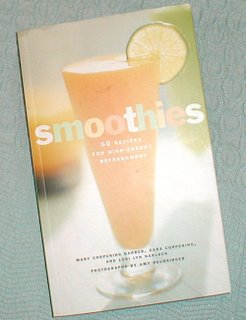
Ahhh, summer. The heat. The allergens. The sunburn.
(Yes, you guessed correctly: Summer is not my favorite season.)
In fact, heat like we've had recently makes we want to hide deep in the recesses of my house. And even with the lights off and the air on, cooking can seem like quite a chore in times like these.
I came across this beautiful little book during a summer I spent in Minneapolis.
Before I lived there, I imagined Minnesota would be quite different from Indiana in the summer. When I traveled there during the spring break before my summer, to scope out housing, it SNOWED in APRIL, for crying out loud! Not a flurry, mind you. A ground-covering, fast-falling snow. So I did not expect the 80s and 90s I encountered. And the humidity.
So when this book offered me refreshment, I jumped at the chance.
And it's more than just a few suggestions for fruit combos to produce high-brow Squishies.
There's a glossary of fruits, letting you know when and how to pick 'em, and what to do once you get 'em home. (The standard smoothie fare, oranges and bananas and the like, are there, but have you ever considered a rhubarb smoothie? The authors of this book have. They put a new twist on the classic strawberry-rhubarb combo.)
There's also a look at the extras that make a smoothie a smoothie. Sure, fruit is the dominant flavoring, but the liquids can range far beyond fruit juice. Rice milk, anyone?
The equipment and technique sections are blissfilly short, part of the appeal of smoothies in the summer. Little work, a lot of payoff. What's it take? Here's the short version, straight from Smoothies: "Buy fruit, cut fruit, blend fruit. It is that simple. The average smoothie takes 12 minutes or less to prepare." Heavenly!
The recipes are broken down into four sections: Wholesome Mergers, No-Moo Blends, Decadent Medleys and Drunken Concoctions (for those of you looking for a little less goodness).
So if you're tired of fast food and trying to beat the miserable heat, this book just might be the key.
Originally posted to The Grub Report by Patricia Gibson on August 13, 2007 12:31 PM
Comments
At August 15, 2007 6:31 PM, Nicole Noffsinger said...
Subway used to have the best smoothies and even had where you could have added vitamin supplements added. Is there anywhere around here to get a decent smoothie?
At August 21, 2007 12:02 PM, Angie said...
I just noticed the question Nicole left... Payne's has WONDERUL smoothies! I particularly like the berry blast (with four kinds of berries) - you can have it made with custard or healthy additions. (This is right off of I-69 exit 59, sort of behind Cracker Barrel.) Labels: food, grubreport
>>> READ MORE ... you know you want to.
posted by Tricia at
|
 

THE GRUB REPORT: Ingredient of the Week: Fideos (With Video!)
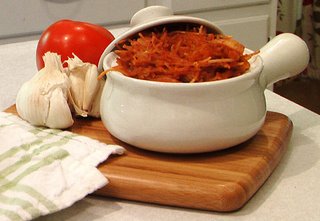 A few weeks ago, Tricia and I were browsing the aisles at a local discount store and were surprised by the selection of food they carried. Not by the quantity, mind you, but by the variety. Because they primarily stock those items that have failed to sell elsewhere, the food offered runs the gamut from exotic to inedible. Intrigued by the notion of purchasing foods available at a discount store, I thought it would be fun to try to make a tasty meal exclusively from discounted items. Sure, the odds were not in my favor, but in the end … well, I'll let you decide. Here's the video. I'm calling it "Dollar Store Gourmet." Fideos with Clams Ingredients 2 7-oz. packages fideos1 medium onion, sliced 2 cloves garlic, minced 2 Tbsp. olive oil 1 14-oz. can chicken broth 2 13.7-oz. packages crushed tomatoes 2 3.5-oz. packages whole baby clams 1 tsp. kosher salt 1 tsp. paprika ground black pepper to taste Directions Bring olive oil to medium heat, and add fideos. Sautee until they are golden brown, and drain on paper towels. In the same pan at medium heat, add garlic, onion, tomatoes, salt, pepper and paprika. Let it simmer for 15 minutes. Add broth and the reserved fideos to the pan and let simmer for an additional five minutes. Add baby clams (along with juices they are packed in) into the pan, and simmer for an additional 10 minutes. Remove from the heat. Preheat broiler, and spoon the fideos into oven-safe bowls. (The flatter your bowls, the more surface area will be exposed to be crisped up.) Place bowls beneath broiler until tops of fideos are browned and crispy.
Originally posted to The Grub Report by Steve Gibson on August 4, 2007 12:59 PM
Comments At August 10, 2007 10:50 PM, Bill Lewis said... Steve Gibson, I think the video is a great idea. Permit me to cite a previous article that suggested ordering specialty food items over the Internet. For example, someone wanting to try your recipe for fideos with clams may be hard pressed to find fideos locally (maybe La Poblanita?). I've used Amazon.com on a few occasions and discovered they have a large variety of specialty foods and ingredients. However, I'd advise your readers to be careful, since the shipping costs can sometimes be more than the item ordered. Your recipe contains two of my favorites, pasta and clams. As an aside, one of my favorite restaurants in the whole world is Umberto's Clam House in New York City. They serve the best linguine with white clam sauce on the planet.(It's in the New York City dining guide and is located in the center of Little Italy. If anyone is traveling to NY I'd recommend it). Umberto's has been prospering in NY for over thirty years. That says something for a city that is very hard on the restaurant trade. Food critics rule and new restaurants come and go overnight based on their reviews. After moving back to Marion, I discovered that there must be a cosmic gazillion varieties of tomato sauce in the local markets, but no white clam. After a quick search I was able to locate a large selection on Amazon. Your idea of "Dollar Store Gourmet" was very good. Maybe next you can try "Gourmet Recipes from Our Sisters of Charity Soup Kitchen". (Just joking) At August 12, 2007 7:25 AM, Scott Hutcheson said... Love the video and love the "Dollar Store" concept! Labels: food, grubreport, recipes
>>> READ MORE ... you know you want to.
posted by Tricia at
|
 

THE GRUB REPORT: Squash fever
It's officially zucchini season. Last Sunday at church, some friends brought in a grocery bag full of zucchini big and small, overabundance from their garden to share. We love zucchini, so we took a few. But what to do with them? It figures into one of our favorite one-pot meals, chicken, rice and vegetables with a Moroccon flare. And back in May, Angie suggested a veggie variation on crab cakes that puts a new spin on zucchini. Of course, there's always the old standby, zucchini bread. But there's a recipe I've been wanting to try for months, or even years: zucchini pie. I'd never heard of this concoction util I attended my first Mississinewa 1812 a few years back. This annual fall festival / living history event is one of my favorite things about Grant County, and the turkey noodle soup and squash pie served by one of the vendors is one of the highlights for me. The first time I tried that squash pie, I vowed I'd make it someday. Today was that day. I had scrounged for recipes online the last time I had the urge to make this dish, but I can't remember which site I ended up pulling this one from. (My guess is Cooks.com.) I used some others there for reference today, trying to come up with the best way to replicate those flavors I savor every fall out at the battlefield. I think this one had the best formula and best directions, except for one thing. It doesn't have a total cooking time. It just instructs the baker to "cook until set." I've baked many a pumpkin pie in my life, and since this is a custard pie that's somewhat similar, I figured I'd have no problem. I was wrong. My pie came out just this side of burnt, and the texture of the filling verged on curdled. (In my defense, I had to leave it in a warm oven so as not to be late for work, because it still seemed to jiggly to remove. I think that was what pushed it over the edge.) But the taste! It was just what I was hoping for! So next time, I'll know that "set" for this pie is still rather loose. It's more runny than your typical pumpkin filling, and the end result should be far less dry. Now I know. In the meantime, I'll be enjoying my not-quite-perfect pie anyway. Here's the recipe I used: Zucchini PieIngredients 1 1/2 cups zucchini - peeled, seeded and sliced 1 cup evaporated milk 2 cups white sugar 1 egg 3 tablespoons margarine or butter 3 tablespoons all-purpose flour 1 teaspoon vanilla extract 1 pinch salt 1 recipe pastry for a 9-inch single crust pie (or a store-bought crust) 1/2 teaspoon ground cinnamon 1/4 teaspoon ground nutmeg Directions Boil zucchini until tender. Drain and let stand in cold water for about 5 minutes, then drain. (Alternately, spread out on a heat-safe surface and let cool, which is what I did while I was making my pie crust dough.) In a large bowl, combine zucchini, evaporated milk, sugar, egg, margarine, flour, vanilla and salt. In two batches in a blender, blend until smooth. (I tried to put it all in the blender at once, as the original recipe said. Boy, what a mess I made!) Pour into unbaked pie shell. Sprinkle with cinnamon and nutmeg. Bake at 425 degrees farenheit for 5 minutes. Reduce heat to 325 degrees and bake until set. (And remember, this is a very loose set. It will still be very jiggly, but it will firm up in the refrigerator. Next time, I'll start with about 45 minutes, and go from there.) Do you have any recipes you turn to when you have extras from the garden? Originally posted to The Grub Report by Patricia Gibson on August 2, 2007 11:34 PMLabels: food, grubreport, recipes
>>> READ MORE ... you know you want to.
posted by Tricia at
|
 

THE GRUB REPORT: Arrivederci, Garlic?
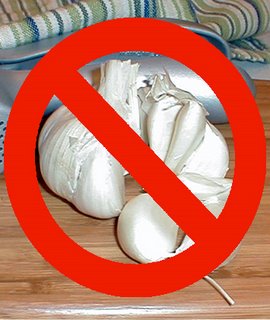 Throughout history, attitudes toward garlic have shifted back and forth. Some early Christians believed that it first grew from the footprints left behind by Satan after he left the Garden of Eden, thus proving it the most evil member of the onion family ... Beelzebulb. Then, of course, you have the numerous European cultures who believed the plant to have protective powers. A little dab of the potent little bulb around even the slightest openings was sure to protect your house from ghosts, demons, werewolves and a wide variety of Draculas. Today, I think that we have sided with the latter group. While we don’t attribute any supernatural qualities to garlic (apart from being magically delicious), we know now that the old-timey ideas about its protective powers weren’t so far off base. In fact, many scientists believe it provides a number of health benefits. It has been touted as an anti-inflammatory, effective in reducing pain associated with arthritis. Some have said it is an anti-bacterial, able to put the kibosh on those nasty infections that seem to get passed around every few months. Some even say cooking meat with garlic greatly reduces the cancer-causing agents that result from the cooking process. Despite all of the positive claims about garlic, a growing faction of cooks and food enthusiasts shares the aim of banning garlic in the cuisine of (gasp of shock and horror) Italy! "No!" you say. Yes, the birthplace of all things garlicky and wonderful is turning against garlic, citing its overpowering flavor, indigestibility and general stinkiness as reasons for giving it the boot. Don't believe me? Check out the article here, and then come back and share your favorite garlic-centric recipe. (Thanks to Susan for the heads up on this story!)
At July 26, 2007 11:32 PM, Bill Lewis said... Steve Gibson, how do we know we are not being mislead by a coven of vampires? They could be the actual masterminds behind the anti-garlic campaign in Italy! (I couldn't resist that). It's interesting how many myths have revolved around food. I agree with you that most of the enlightened world has thrown off these holdovers from medieval times. However, I'd like to point out that they still exist in some rural and isolated areas of Europe, and here in Indiana for that matter. I cannot seriously envision Italian cooking without garlic, olive oil and tomatoes. Those are the three basic ingredients of Mediterranean cooking. I've noticed some recipes will substitute shallots for garlic if some find garlic bothersome. (I use both for some recipes).
Since portobello mushrooms have been currently available at Marsh (the north Marion store) I will share my simple recipe for sauted portobellos. (Portobellos have been jokingly described as overweight creminis). I've discovered that the flavor of mushrooms is greatly enhanced by garlic. Cut the mushrooms in strips and saute in olive oil and garlic, (I add a little butter as well), salt and pepper to taste. Saute until tender. Sprinkle with chopped parsley. The whole process only takes 10-15 minutes and can provide an easy to prepare, different and delicious side dish. Labels: food, grubreport
>>> READ MORE ... you know you want to.
posted by Tricia at
|
 

THE GRUB REPORT: Ingredient of the Week: Lychees
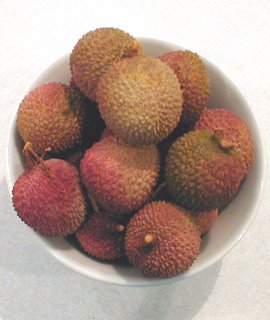 When I'm at the grocery, I often find myself grabbing exotic items even though I have no real plan as to what I might do with them. It's due to the transient nature of the produce section at local groceries. What's here today might not and probably won't be here tomorrow. So, you have to forget about planning meals ahead of time. You gotta get what there is to be gotten now and figure out a way to use it later. Such was the case when I happened upon a display of lychees. Lychees are native to China and a staple of many Asian cuisines. They have a tough skin that's easily removed to reveal a somewhat fibrous white flesh. Their taste is a bit musky and unlike any other fruit that I can think of. Since my experience with lychees has been exclusively in the realm of Thai cuisine, I felt like I should incorporate some of the classic flavor combinations from the region. Red snapper is pretty abundant in the Indian Ocean, and in Thai cuisine it is often paired with citrus or chilies to contrast its delicate flavor. In our recipe, we forgo the citrus in favor of lychees in order to give the dish a subtler, more complex flavor. Red Snapper with Lychee Chili Sauce Ingredients
Sauce
1/3 cup lychees, chopped
2 shallots, chopped
1 red chili, seeded and chopped
1/2 inch ginger root, peeled and chopped
1 tsp. brown sugar
1 Tbsp. fish sauce (optional) Fish
4 red snapper fillets
4 Tbsp. soy sauce
1 Tbsp. vegetable oil
6 scallions, sliced
2 Tbsp. cilantro
1 red chili, seeded and sliced lengthwise Sauce
Combine lychees, shallots, red chili, ginger root, brown sugar and fish sauce in a blender. Blend until the mixture is smooth. Fish
Cut four or five shallow, diagonal slits on the skin side of your snapper fillets and place them in a shallow pan. Coat both sides of the fish with the soy sauce. Heat the oil in a large frying pan, and fry the fillets, one at a time, for five minutes on each side, or until the skin is browned and the flesh is tender and flaky. Spoon the lychee chili sauce over the fillets and garnish with cilantro, scallions and red pepper strips.
Originally posted to The Grub Report by Steve Gibson on July 19, 2007 08:43 PM
Comments
At July 21, 2007 12:10 AM, Bill Lewis said...
Steve Gibson, that looks like a very good recipe. I'm going to try this one if I can find some red snapper. I've seen lychees in the market.
My first taste of Asia, in Asia, was dried lychee "nuts" usually served with other appetizers during the pre-dinner cocktail hour(s). (I was "immersed" in Asian culture almost immediately after graduating from college and leaving Indiana. My first assignment was in East Asia where I spent an interesting thirteen months.) Fresh Lychees were usually included in fruit salads during the summer months. I always thought they tasted, and the fresh ones resembled, strawberrys. At July 22, 2007 11:12 PM, Steve Gibson said...
Bill, I love hearing about your travels and hope one day to have the opportunity to visit some of these places myself.
Oddly enough, I discovered lychees at a Thai restaurant in Minnesota. It was the same day that I discovered the fruit called, "durian." They told us that we didn't want it, but that just made us want it all the more.
I know now that they were right. They brought it out and it smelled like an open sewer.
I guess in Thailand they actually have banned the eating of durian on the subway due to the stink! Yeah, I think I'll just stick to the lychees. At July 25, 2007 2:46 PM, Bill Lewis said...
Steve Gibson, I'm hesitant to relate my travel/culinary experiences for fear it will be interpreted as bragging. I can assure that is not my intent. My job(I'm retired) required a lot of travel. The job related travel, in addition to my personal trips, have taken me almost around the world (literally).
I've not heard of "durian" but based on your description that is a culinary experience I will avoid. Of a similar nature Korea has a national dish called kimchi. It consists of fermented vegetables and is usually heavily seasoned. The smell alone is enough to discourage any casual American tourist from sampling it. In this particular case I will say "thank God for McDonalds in East Asia (not Europe).
I really enjoy your Blog and thanks for permitting me to provide my small contribution.
Labels: food, grubreport, recipes
>>> READ MORE ... you know you want to.
posted by Tricia at
|
 

THE GRUB REPORT: Kitchen Tool Box: Immersion blender

As a person who enjoys food a great deal and spends a lot of time cooking, when gift giving holidays roll around, I usually score more than my fair share of kitchen gadgetry. Of course, a lot of the stuff out there is good for one or two specific jobs and hardly worth the trouble of pulling them out from the dark recesses of the cabinets, but every now and again you find something you never knew you couldn't live without.
Quite a few such treasures have found their way to our house over the years by way of discerning family members. One of them is the immersion blender I received two Christmases ago.
Also known as a stick blender, an immersion blender is the Great Compromiser of the kitchen. Honestly, there is no single blending job that an immersion blender does better than any other piece of kitchen equipment, but what it can do is perform many of the tasks relegated to food processors, bar blenders and food mills pretty darn well.
Where this little baby really earns its keep is during clean-up. At the sink, your average bar blender or food processor becomes a brain teaser, defying you to disassemble, clean and then reassemble it in a timely manner. Cleaning an immersion blender, however, is as easy as running the blade in a little bit of soapy water.
If you have a blender and a food processor, I'd say that there's no real need to go out and get one of these. It will save you a lot of time cleaning up but will not offer any applications you cannot already perform. If you have neither a blender nor a food processor, though, you might consider buying an immersion blender instead.
Immersion blenders can come with a lot of bells and whistles. Mine, the Cuisinart Smart Stick, has three additional attachments that I've never used. But above all things, I think there are two key features you should always seek out when shopping for an immersion blender. A metal shaft is essential. It will allow you to blend directly in a pot, without worry that the intense heat will adversely affect your equipment. Also, avoid single piece models. Sure they are cheap, but the easy clean-up argument is moot if you can't remove the blending shaft for cleaning.
Since we've been writing the Grub Report, I've rediscovered the stick blender's many talents. In just about every blending application (Salsa Verde, Curry Paste, Hummus) I've opted for the stick blender over other options, and I've come to wonder why I waited so long to move it up to the varsity squad.
Do you have any kitchen equipment you can't live without?
Originally posted to The Grub Report by Steve Gibson on July 18, 2007 11:50 AM
Comments
At July 19, 2007 12:59 PM, Margaret Adams said...
I have two kitchen gadgets I can't live without. 1. My mini chopper. I use this little gadget to cut everything.2. My little brother that I can get all kinds of ideas and recipe's from. Really like your blog.
Labels: food, grubreport
>>> READ MORE ... you know you want to.
posted by Tricia at
|
 

THE GRUB REPORT: Ingredient of the Week: Figs
Okay. I admit it. We fudged on the rules a little this week. Our beautiful fresh figs came from one county over. But when I saw them at a grocery store in Muncie, I just couldn't pass them up. Fresh figs are one of those foods I covet. There's just nothing like them. The dried or Newtoned varieties are fine, but they can't hold a candle to the sublime smell, taste and texture of the fresh fruit, in my book. I remember the first time I had a fresh fig. It was straight from the tree in the back yard of my uncle's parents, immigrants from Italy who had settled in California. I've loved them ever since. The figs we found were the deep purple, plump, teardrop-shaped Mission variety. They came five to the package, piled in one of those ubiquitous plastic hinged-lid produce boxes. And when my family came up for a visit last weekend, it was the perfect opportunity to make a simple, fresh dessert that showcased the figs. I picked up a small tub of ricotta cheese (another of my favorite ingredients) from a local grocery and used about half of it, and I pulled out the tarragon (one of my favorite herbs) that was in our fridge, left over from a batch of tarragon butter that accompanied steaks we grilled recently. I also had to pick up a new bottle of honey, and opted for the darker (and consequently cheaper) version, because I wanted a heavier flavor. The resulting dish was nothing short of divine. Or at least my dad -- from whom I must've inherited my love of figs -- and I thought so. I have to admit that the rest of the group were underwhelmed. The reviews ranged from "It's OK" to "It's weird." So if you find fresh figs and try this concoction, you'll probably get mixed reviews, too. But you may just find that you, too, will become a fig devotee and dream of the day when you'll get the chance to enjoy them again. Here's the recipe: Fresh Figs, Tarragon Ricotta and HoneyIngredients Fresh tarragon leaves, roughly chopped (I'd estimate it was a teaspoon or a little more, but you could vary it to your taste) Ricotta cheese (about half a small tub is enough for five figs) Fresh figs (any variety will likely do, but Missions work great with this flavor combo) Brown sugar (about a half a teaspoon per fig, or more if you wish) Honey (enough for generous drizzles across each portion) Instructions Mix the tarragon into the ricotta, preferably a few hours before so the flavor infuses into the cheese somewhat. Set the oven to broil. Slice the figs in half from top to bottom, and place them on a sheet pan or any oven safe dish. Sprinkle generously with brown sugar, and broil for a few minutes. (Time will vary from oven to oven. Just make sure you keep close watch on them. You want the sugar caramelized, but the difference between that and burnt is a matter of seconds.) Let cool while you prepare the plates. Spoon cheese onto plates. ( Quenelles are a nice way to go, but any neat mound or dollop will do, really.) Place the figs next to the cheese, and generously drizzle all with honey. Do you have any foods you love but can't often find? Or do you have any memories of the first time you tried a favorite food? We'd love to hear about them. Originally posted to The Grub Report by Patricia Gibson on July 11, 2007 07:30 PMLabels: food, grubreport, recipes
>>> READ MORE ... you know you want to.
posted by Tricia at
|
 

THE GRUB REPORT: Friday Night Mega-Bites: Chocolate and Zucchini
This week's Mega-Bite showcases one of the fabulous things about food: the fact that so many of our memories are tied to it.
I've been to Paris twice.
The first time, I was in high school and traveled there with other members of the Spanish Club. (Yes, we went to Spain too.) We spent a few days there, and the thing I remember most about the food is actually the breakfast we were served at the hotel. Those breakfasts sparked my love of real, buttery, not-to-sweet croissants.
The second was a day trip from London, with my then-boyfriend, now husband, Steve. We were both studying at Ball State's London Centre at the time, and took the opportunity during a break from classes to spend a day in Paris. The only thing I remember eating that trip was a baguette and some Laughing Cow brand cheese.
It's a startlingly beautiful city, but it can be a bit abrasive and overwhelming, too.
But reading this week's featured Web site, Clotilde Dusoulier's Chocolate and Zucchini, overshadows any negative feelings I still carry and reminds me of what is fabulous and beautiful there.
Chocolate and Zucchini is a great place to go to get inspiration and recipes. It's almost a diary of Clotilde's daily kitchen adventures. And the discussions tagged onto the blog entries usually feature Clotilde bantering with her readers, passing on knowledge or discoveries or just sharing the wonder of an especially good dish. I'm sure she quickly becomes like an old friend to frequent readers.
Clotilde also recently produced a beautiful book based on her blog. It's on my wish list of cook books to buy.
If you've been to Paris, I'm sure you'll find memories flooding back too. And if you've never traveled there, her blog will fill your imagination with intriguing scenes and inspiration for great dishes to try.
The Web site: Chocolate and Zucchini
Originally posted to The Grub Report by Patricia Gibson on July 6, 2007 09:30 PM
Comments
At July 9, 2007 11:00 PM, Bill Lewis said...
Mon Dieu, mon Dieu, you're in Paris, the capital of the country that produces the best wine and cheese in the world, and you're sampling La vache qui rit (Laughing Cow)? Laughing Cow (gasp) is a processed cheese and the French equivalent of Cheez Whiz.
I agree with you that Paris is a "startlingly beautiful city". On my first trip to Paris I stayed at the Hotel Voltaire which provides a fantastic view of this startling beautiful city. (I am not recommending the hotel since it is currently undergoing renovation.)
I've noticed that the better French hotels usually bake their own croissants daily and that accounts for the "fresh baked" flavor. They really are fresh baked. The same is true of the bread and pastries.
Having grown up in the cultural "backwater" of Marion I was surprised at the high quality of the bread in Paris. My first visit taught me that all bread is not the "doughy" white bread I was accustomed to in Marion. We "manufacture" and "process" bread and cheese here of course but they are not really on the same par as the French products.
I enjoy your Blog very much. Please keep the recipes coming.
At July 9, 2007 11:18 PM, Steve Gibson said...
Bill,
The saddest part is that doesn't even scratch the surface of our culinary atrocities while in Europe. That was back in a time when we were into the "cultural experience" but hadn't yet figured out how it all comes back to the food. Tricia and I were just talking the other day about how we'd love to go back and slap ourselves for not seeking out great food during our time there. I only hope that one day we'll have the opportunity to go back and right all of those wrongs!
At July 10, 2007 12:18 AM, Patricia Gibson said...
I know, it's a travesty. But, in our defense, we were totally out of our element and ran into some testy workers at the metro and the grocery (who refused to serve us if we couldn't converse in French -- I hate to perpetuate a stereotype, but I can attest that it's true in this case). So we grabbed what was familiar on the go, since we only had a day for our whirlwind sightseeing. (No excuse, I know! I wish, looking back, that we would have at least taken the time to stop in a restaurant. But money and time constraints dictated otherwise, and, like Steve said, we didn't know at the time how much we were missing.) To this day, though, Steve won't eat anything with a laughing cow on the label!
At July 10, 2007 9:58 PM, Bill Lewis said...
Steve and Patricia Gibson, I hope you didn't interpret my comments as being critical. That certainly was not my intent. I wanted to point out the humor and irony of your situation. I realize the French can be intimidating to Americans, especially, when it comes to language.
Again, I'm not attempting to be critical but it's always helpful to understand some basics of the language of the country you travel to. For example, I speak a passable French and have not had any difficulties in France or their "departments" in the Caribbean (Martinique and Guadeloupe). You have a very good idea about returning and visiting the attractions you missed the first time. Particularly the great restaurants Paris and Europe has to offer.
I Have currently been traveling in Italy and find it both interesting and educational. However,I feel a little bit at a disadvantage since I don't speak the language. You mentioned that Paris can be a "little bit overwhelming" I found that to be true in Florence. After spending a few days in the Uffizi I was struck with a minor "epiphany". This relatively small area (Tuscany), was the birthplace of the Renaissance, the most significant contribution to culture in world history. No small feat.
My niece just returned from the Ball State London Center and enjoyed the experience so much she didn't want to come back. I think its a very good idea to learn at a young age there is more in this world than Elwood, Indiana. But the experience, for some of us, can be both educational and overwhelming at the same time. But maybe that is not a bad thing.
At July 11, 2007 7:28 PM, Patricia Gibson said...
Bill:
No offense at all taken! The irony is well-recognized on our end. It's a running joke, really, with us that we traveled to what is arguably one of the culinary capitals of the world and didn't manage to take advantage of it!
As far as language barriers go, a mission trip to Mexico kind of revolutionized my outlook on that. As we were crossing the border back into the U.S., a border guard, half in jest, initially insisted we converse in Spanish with him. I've taken several years of Spanish classes, but only a rudimentary grasp of the language has stuck with me. And in an intimidating situation like that, even that knowledge escaped me. Once the guard gave us a good scare, he relented. But it really opened my eyes as to how selfish it is that we assume everyone should be able to speak perfect English, here and anywhere we go in the world, if they want to converse with us.
(But I'd never let that stop me from traveling, if I had the means. I'd like to think I've become a little more savvy along the way since our day in Paris, and I think today the experience would be quite different.)
I agree wholeheartedly about traveling at a young age. It is amazing how much you can learn about the world and yourself. And you'll never find a better deal than those student trips! I always tell people considering overseas study to go for it, if they can afford to at all. Labels: food, grubreport, mega-bite
>>> READ MORE ... you know you want to.
posted by Tricia at
|
 

THE GRUB REPORT: Ingredient of the Week: Tomatillos (plus a video!)
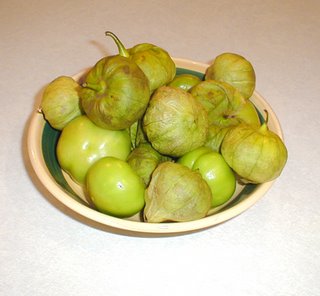 Blogging each week on a specific ingredient has helped me grow accustomed to explaining my purchases when I reach the checkout at the grocery. It never fails. The cashier can be completely zoned out and ambivalent to my presence, but as soon as they get to that one moderately obscure item, they wanna know all about it. This week, I had resigned myself to the fact that I'd most likely not get to have my little food chat with the cashier. Tomatillos, after all, aren't exactly exotic, right? Well, to tell you the truth the cashier showed more interest in my bag of little green spheroids than I have ever been confronted with. She asked a few questions about them, and I did my best to answer them. Then, the bag boy also got in on the action, asking what they were and what I was going to make with them. It was a little bit awkward, and I began to feel as though people were craning their necks to see what kind of alien produce I was buying. I am truly convinced that if I would have stayed long enough, they would have called the manager over to marvel at them for a while. I guess it's pretty cool that people are interested in learning more about foods they might not immediately reach for on their own. Honestly, though, tomatillos shouldn't be that scary. As the name implies, they are related to the tomatoes you and I slice up for our burgers, but admittedly have a look and a taste that's very different. While they are usually covered in a dry, brownish husk, the actual fruit of a tomatillo is (or should be) brilliantly green and firm. (It's actually in its unripe stage, but that's when it's best.) The fruit has a fresh, tart flavor that lends well to a variety of applications (one of my favorites is a pork loin recipe from Emeril: Bam! ); the most traditional use of the fruit is in salsa verde. While salsa verde can mean any variety of green sauces used south of the border, the most popular use of the term refers to the sauce made with tomatillos. Similar in many ways to the red salsas made with tomatoes, salsa verde has a much brighter, tart flavor. Feel free to switch out this salsa verde in just about any application where you'd use standard salsa, including but not limited to sitting on your couch with a bag of Tostidos. Salsa Verde Ingredients
4 cups tomatillos, husked, rinsed and diced
1 medium onion, diced
4 cloves garlic
1/2 cup chopped cilantro
4 jalapeno peppers, seeds removed
1 tsp. salt Directions Roast the jalapenos under the broiler (find the tutorial here) Combine all of the ingredients in a food processor (or in a bowl if using an immersion blender) until pureed. Cover and refrigerate. So, I suppose you're wondering if salsa verde is available at the grocery, in jars just like the red stuff we love so much. Of course it is, but the real question you should be asking is whether or not it's as good as the homemade. Well, we've decided to do the taste test for you. Check out our very first video (yup, I said first ... so be gentle) wherein we pit store bought salsa verde against our very own recipe in a no-holds-barred bout that I'm calling "Supermarket Death Match." Watch it here. Originally posted to The Grub Report by Steve Gibson on July 4, 2007 02:50 PM
Labels: food, grubreport, recipes
>>> READ MORE ... you know you want to.
posted by Tricia at
|
 

THE GRUB REPORT: Cooking the Books: Cookwise
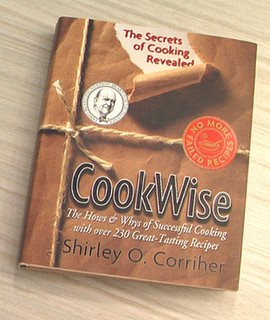
We have a pretty ample library of cookbooks in our kitchen, but despite the quantity they can all be divided in to two distinct categories. The majority of them are recipe collections. You know, those old ragged tomes where you've dog eared your favorite peanut butter cookie recipe or the recipe for the only edible tuna casserole in existence. Then there are those precious few that serve as reference books. Sure they have recipes, but their primary goal is to teach, to provide you with universal truths that you can use to overcome a variety of kitchen conundrums. This week's featured book, Cookwise by Shirley O. Corriher, falls into the latter category. Think of it as a lab manual for your kitchen. Each chapter is like a unit of study focusing a specific realm of cookery (bread, pasta, desserts, etc.). Shirley demystifies the cooking process by presenting the science in terms even a dolt like myself can understand and explains why successful cooks do what they do.
After you've finished reading your "lesson," she provides you with a recipe as a sort of application assignment, a chance for you to test out what you've learned.
Be sure to check out the "Round Rueben" recipe. It's a Rueben sandwich that's actually baked inside a big round of rye bread. I took it to a Super Bowl party a couple of years back and am still hearing about it!
They have this book at the library. But you're going to want to buy it. And a highlighter. You'll want to take notes.
Originally posted to The Grub Report by Steve Gibson on July 2, 2007 11:57 PMLabels: food, grubreport
>>> READ MORE ... you know you want to.
posted by Tricia at
|
 

THE GRUB REPORT: Friday Night Mega-Bites: The Good Beer Show
Tricia and I have been spending the last month or so sampling the seasonal offerings down the local beer aisles, and I have come to one conclusion (those of you who consider beer flavored with fruit blasphemy might want to look away here): Leinenkugel's Summer Shandy is pretty much the nectar of the gods. Admittedly, it tastes more like lightly hopped lemonade than a lightly fruited beer, but after a brutal session of lawn mowing, I could probably put down a gallon of the stuff. So, yeah ... it's probably clear that I know next to nothing about good beer, but I'm learning with the help of this week's Friday Night Mega-Bite. The Good Beer Show, a podcast produced just down the road a ways in Muncie, is a loosey-goosey discussion of all things beer. Ringmaster Jeffrey T. Meyer and his "merry" band of drinkers review the wide variety of micro-brews and imports available at The Heorot, one of the largest beer halls in the Midwest. It's a party atmosphere, beer-fueled discussions on beer (not for the faint of heart!) with a little bit of local rock and roll thrown in for good measure. Check it out, and you may swear off of "big brother beer" for good. The Web site: The Good Beer ShowOriginally posted to The Grub Report by Steve Gibson on June 22, 2007 11:45 PMComments At June 25, 2007 10:11 PM, Bill Lewis said... Steve Gibson, another good article. In the immortal words of the great philosopher and strategic thinker Frank Zappa, "You can't be a real country unless you have a beer and an airline...or some nuclear weapons, but at the very least you need a beer." Wisdom in its highest form. I have a tendency to be a hidebound traditionalist when it comes to beer. I'm not very fond of the fruit flavored varieties. In my humble opinion, if you want a fruity flavor, buy a good Beaujolais.(Marsh has a good "Beaujolais-Villages" that is moderately priced). When you imagine the combination of "beer and country" Germany quickly comes to mind. Beer has been a traditional part of the culture for probably several hundreds of years. This is manifest in the annual "Octoberfest" which began in Bavaria and seems to have spread throughout much of the Western world.(Obviously Muslims have problems with the Bacchanalian nature of the festival.) However, I think it's going to take some time for fruit flavored beer to be accepted in Munich. A rasberry flavored lager? Come on Steve!!! Labels: food, grubreport, mega-bite
>>> READ MORE ... you know you want to.
posted by Tricia at
|
 

THE GRUB REPORT: Ingredient of the Week: Frog Legs
 It's ironic that what's available in our own backyards is often considered exotic eats. I'm constantly spotting snails sliming their way up and down our deck, but I have yet to work up the nerve to break out the garlic butter and enjoy some escargot. And while I get downright angry at them eating our tomatoes, the idea of stewing up a cute and fuzzy bunny for a little hasenpfeffer nearly brings a tear to my eye. Why do we shy away from snacking on those critters that are so readily available? My guess is because they aren't available at our local mega-marts and we are so disconnected from the preparation of our own meats that we'd never think of doing it for ourselves. Come to think of it, that's probably smart. While many decry the modern grocery as the reason that "we don't know where our food comes from," it has most likely contributed to the longer life-expectancy we enjoy these days. To be quite honest, I'd rather go through life believing that meat spontaneously appears shrink-wrapped on polystyrene trays than wind up raving mad after gnawing at the hind quarters of a sickly animal. So, it's probably best to let the backyard beasties be until such time as they appear at your local meat counter. For me, that day came sooner than I expected. The other day while cruising the grocery aisles I came across an oddly beautiful sight. It was a chorus line of hefty frog legs looking like they were ready to begin high kicking to the strains of "Hello Ma Baby". I had never tried them, but I knew that they were considered a delicacy in many cultures. The cuisines of France and China have a tradition of using frog, but around here, if you wanna do frog legs right, you gotta go south. Our recipe is essentially a variant on southern fried chicken. I mean, what do you always hear? It tastes like chicken, right? We actually thought the flavor, and texture for that matter, tended more toward fish. Regardless, we hope this recipe will serve to simultaneously put the squeamish at ease and please the most diehard frog fans out there. Southern Fried Frog Legs Ingredients 4 frog legs 2 cups buttermilk 1 cup all-purpose flour 1 tsp. Old Bay1/4 tsp. garlic powder 1/4 tsp. onion powder 2 tsp. salt 1 tsp. black pepper 2 eggs, beaten 2 cups panko bread crumbs (*see note below) vegetable oil (for frying) Directions: Pour buttermilk into a bowl and add frog legs to marinate for at least one hour. Toss once or twice to ensure a good soak. Mix flour, Old Bay, garlic powder, onion powder, salt and pepper. Remove the frog legs from the buttermilk, and dredge in the flour, then in the beaten eggs and finally in the breadcrumbs. Set the legs to the side while you preheat the oil for frying. Once the oil is heated, fry the legs on both sides until they are evenly browned (approximately 6 to 8 minutes). *A note about panko: Panko -- often stocked in the small Asian staples section at grocery stores -- is a Japanese-style breadcrumb that is more coarse and flaky than the breadcrumbs you might be used to adding to meatloaf and the like. It is fabulous for breading, and will make a real difference. If you can find it, use it. You'll be glad you did.
Originally posted to The Grub Report by Steve Gibson on June 20, 2007 03:11 PM Comments
At June 22, 2007 11:09 PM, Bill Lewis said... Steve Gibson, great article. I can remember my dad cooking frog legs when I was a kid here in Marion. One bit of advise though, you may want to cut the Achilles tendon before sauteing. They have a tendency to "jump" while being cooked because of the expansion of the tendon. This "jumping" could scare the poop out of a novice chef. Your chicken recipe looks very good. There is a French version for "Cuisses de Grenouille aux Herbes" that calls for drenching the legs in flour and sauteing in butter and garlic until brown and served with parsley. Detailed recipe may be available on-line. I tried Escargot in a small bistro in Montmarte(northern Paris) called Le Cirque. (I could not leave France and say I had not tried Escargot.) They were fabulous. I think the taste comes more from the garlic and butter sauce than the snails themselves. Both Escargot and Grenouille are generally served as appetizers in French restaurants. Speaking of local delicacies, what about the Morel mushroom, which grows wild in this part of Indiana. We used to "hunt" them in the woods around Marion but we referred to them by another name. (A name which is too obscene to print.) We would soak them in salt water overnight to get the bugs out of the cells. They are fantastic sauteed in butter and garlic.I noticed they had them in Marsh for almost $50 a pound. Talk about sticker shock. Labels: food, grubreport, recipes
>>> READ MORE ... you know you want to.
posted by Tricia at
|
 

THE GRUB REPORT: Friday Night Mega-Bites: The Hungry Hoosier
If you're anything like us, you tend to plan your trips around food. I've put in hours of research to keep from missing that "can't miss" meal while on vacation, but, sadly, right here in my own state I've been content to stumble about blindly, trying unknown restaurants at random. It's a hit-or-miss affair at best. This week's Friday night link promises to put an end to the madness. The Hungry Hoosier is the ultimate guide to eating out in the Hoosier state. Food writer Scott Hutcheson travels near and far to give us the lowdown on Indiana's eateries. With the copious amount of news and reviews cross-referenced by city and county, planning your next gastronomic odyssey will be a breeze. Seeking out good food is an easy way to make even short trips special. And with gas prices as high as they are, being able to find the good stuff close to home might be the key to keeping to keeping both your wallet and your stomach full. The Web site: The Hungry HoosierOriginally posted to The Grub Report by Steve Gibson on June 15, 2007 11:10 PMComments
At June 18, 2007 3:47 PM, scott said... Steve: Thanks for the pointer to my site. I like the blog you guys have here. Keep up the good work! Scott At June 18, 2007 4:12 PM, Adam Wire said... Another good source is a book titled "Dining Secrets of Indiana." I bought my copy at a Barnes & Noble a few years back, if I remember right, and it's updated every few years (to account for restaurants that have opened or closed since then). Grant's County's own Ivanhoe's is mentioned in my copy, as well as The Hostess House and Converse's Herschberger Essen Haus. See you next time you're in the mood for Carnitas. At June 18, 2007 8:08 PM, James Cramer said... Cool site! It is always fun for me to try a new restaurant in a new place but I am always taking a chance on being disappointed. It is nice to have some sort of guide. But it looks like we need to invite him to dine with us in Grant County so we can get a few more listings. At June 19, 2007 2:48 PM, Bill Lewis said... I have an autographed copy of Michael Atwood's "The Best of Heartland Cooking". Atwood was at Waldenbooks (in Marion) for a book signing a few years ago. It contains some unique recipes. I don't know if I'd really recommend it or not. However, I agree with James Cramer. This is a "cool site". Labels: food, grubreport, mega-bite
>>> READ MORE ... you know you want to.
posted by Tricia at
|
 

THE GRUB REPORT: Ingredient of the Week: Gooseberries
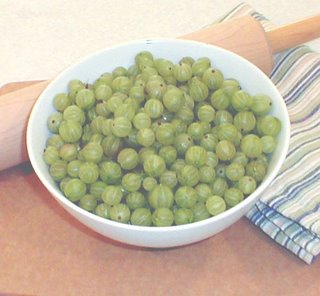 As a kid, I loved gooseberries. So sweet, so succulent, they were my favorite part of the canned fruit cocktail we often enjoyed as dessert. While the fruit ratio was obviously skewed to encourage the coveting of cherries, it was always the pale green orbs that I kept in my bowl to savor after everything else was gone. A few years ago, I had the opportunity to assist in the baking of a gooseberry pie and couldn't resist the urge to pop one of the beautiful berries in my mouth. In about a sliver of a nanosecond, I realized that something was wrong. These were not the sweet and succulent treats of my youth. No, these seemed more like little caplets of battery acid; sour beyond all comprehension. And my mouth, completely independent of my brain, decided to evict the fruit. With my mouth agape, my face twisted in abject horror, and (with gooseberry innards dribbling down my chin) I was the laughing stock of the kitchen. I had inadvertently revealed my ignorance of the fruit known as the gooseberry. As you probably already knew, what I grew up thinking were gooseberries were, in reality, grapes (made tastier by steeping in heavy syrup). And the implosion of my tongue upon meeting with an actual gooseberry will always stand as a harrowing reminder to question bizarre and often downright incorrect hillbilly nomenclature I grew up with in the kitchen. (Not to get too far off topic, but another hard lesson learned involved the difference between mangos and green peppers.) Despite the pain and distress dealt to my mouth, I did discover that, prepared correctly, gooseberries can be a beautiful thing. So, when a big bag of fresh berries came my way over the weekend (Tricia's mom looks out for us like that) I knew right away that this week we'd be making a pie. I know that you can pick up gooseberries canned in a syrup, so please be aware that this recipe calls for fresh berries. Using all of this sugar with the canned berries would most likely cause your teeth to disintegrate halfway through your first slice. Also, you should know that before you get to the fun stuff, you have to pull the stems and tails off of each ... individual ... berry. It's a bit tedious, but worth the effort. It took me just a hair less than an episode of SVU to do a quart of berries. Finally, a note on crust. Everybody has their favorite recipe. For a basic crust we often turn to a Pillsbury cookbook that we've had for years. But there is no shame in getting a little assistance directly from the Dough Boy himself. Crusts from the refrigerated section of your grocery are surprisingly flaky and infinitely easier than rolling out your own. Gooseberry Pie Ingredients
4 cups fresh gooseberries
1 cup sugar
3 Tbsp. quick-cook tapioca
2 Tbsp. unsalted butter
1/4 tsp. nutmeg Cut stemmed gooseberries in half. Mix berries and sugar in a saucepan over medium heat. Stir until sugar is dissolved and mixture is clear (about five minutes). Stir in tapioca and simmer for five minutes. Stir in butter and nutmeg and allow the mixture to cool. Preheat oven to 400 degrees. Fill a 9-inch pie crust with the filling and cover with a second 9inch crust. Press to seal the crust edges and cut slits in the top to vent. Bake for 20 minutes, then cover the edge of the pie with foil. Bake an additional 30 minutes. Originally posted to The Grub Report by Steve Gibson on June 14, 2007 03:45 PM Comments At June 16, 2007 8:55 AM, Misty Henry said... Lol, my grandmother in Logansport had a bush of these growing in her backyard-I got ahold of one just one time, and had the exact same response! So when you started out that they were sweet, I was really confused! I had to laugh at your experience with them. At June 17, 2007 11:56 PM, Bill Lewis said... Your comment concerning the confusion over mangos and green peppers brought back memories. I was born and raised in Marion and many people,when I was growing up, referred to green peppers as mangos. I left Marion and worked on the east coast for over thirty years. One of the first, of many, misconceptions I was corrected on was the definition of a green pepper and how it was completely different from a mango. I wonder how they became confused in the first place? Labels: food, grubreport, recipes
>>> READ MORE ... you know you want to.
posted by Tricia at
|
 

THE GRUB REPORT: Cooking the Books: A Book of Middle Eastern Food
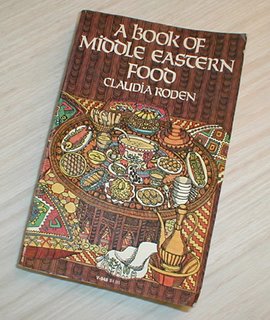
One of the most fascinating things about food, for me, is the fact that it's something we share with every single person on the globe, now and as far back as the history of humankind goes. Think about it. The ingredients differ, and some of the techniques do too, but the aim is the same, and always has been: to provide nourishment and enjoyment. Just as I relish the opportunity to cook up something tasty, so do other young women on the opposite side of the globe. Is it any wonder that cooking utensils and preserved bits of food are some of the most telling finds in archaeological digs? We are, indeed, what we eat, and so goes the history of the world.
That may be why I find old cookbooks so intriguing.
As Jim Cramer mentioned in the comments of the last edition of Cooking the Books, there are real gems to be found beyond the shelves of the local book store or the virtual shelves of today's online retailers.
You can find them in boxes at auctions and garage sales, on shelves or bins at antique stores, used book stores or even junk stores, in piles at your friends' and family members' houses.
One of my favorites came from an interesting used book store down in Madison, Ind., called The Red Onion. If you're a book lover, be prepared to spend quite a long time if you ever decide to visit!
Roden, in the book's introduction, says she hails from Cairo but moved to Europe as a girl. She recounts how food was her connection to her homeland. And can't we all relate to that? If you've ever traveled, or moved, or even seen the demise of a beloved hometown restaurant, the longing for the smells and tastes that are now out of reach can be the strongest manifestation of homesickness.
If you work that equation backward, though, you can transport yourself to parts of the globe you may never actually visit. Adding new flavors and techniques in your own kitchen can be just as eye-opening as an exotic vacation. And for that, this book is a treasure trove. The introduction gives the reader a glimpse into the culture of food in the Middle East, expanding your awareness beyond simple ingredients and dishes. It's as much an anthropology lesson as it is a cookbook!
Many of the recipes themselves, though, may be too much for the casual cook. The book assumes a mastery of technique and is by no means a step-by-step guide, as many modern cookbooks are. Modern cooks would likely have to do some of their own research, online or in other books, to be able to make good use of Roden's instruction. But that's not to say there is a lack of inspiration in the pages of this cookbook. The combinations of ingredients offer a whole new world of flavors that can help you revolutionize your own cooking, even if you don't follow Roden's recipes.
And that, to me, is one of the most exciting things about a book like this. It may not be the most used book on your shelves, but it will certainly color your culinary world.
So if you're dreaming of a trip to far-off lands, consider taking some new ideas for a spin in your kitchen instead. Head to a used book store or an antique store. Ask your family members if they have any unusual old books stashed somewhere. Then spend some time with your finds. Flip through the pages with no particular aim in mind. If you're looking for a specific dish, you'll miss a lot of the inspiration along the way.
Originally posted to The Grub Report by Patricia Gibson on June 11, 2007 12:35 PM
Comments
At June 13, 2007 5:31 PM, James Cramer said...
Eating is not just about the cooking. If you are going to eat Middle Eastern cuisine go for the full experience and do it up right.
Kick off your shoes and eat sitting on the floor. Throw down and spread out some rugs and small pillows. Place the food on a low table in one large central dish for all to share. Put a bowl for washing your hands on or near the table so you can wash before and during eating.
Only eat from your place in the community bowl in front of you, no reaching across. Don't use forks, spoons, or knives. Use your hand to eat, however, only your right hand. It is bad manners to use your left hand. The right hand is exclusively used for all public functions. These include shaking hands, eating, drinking, and passing something to another person. Using the left hand is an insult. And remember that the soles of your feet should not point directly toward someone else. (This is also bad manners, and may bring "bad luck" to that person.)
Remember to make it fun. Here are some foods I suggest for you to enjoy.
Kibbeh - Lamb, beef and cracked wheat.
Samboosak - Beef patties
Lamb Shishlik - Marinaded skewered lamb ("Shish Kebob in in USA)
Al-Motubug - Pastry stuffed with beef
Mejadra - Lentils and rice or cracked wheat.
Tomato Salad
Tabouleh - cracked wheat, parsley and mint salad
Falafel - fried ground beans form the basis for a Middle East fast food.
Baba Ghannouche - Aubergine (Eggplant) salad with tehina
Humus bi Tehina - chick pea and sesame salad
Muhamara - hot pepper dip
Tahinat el Beid - dip for breadTurkish Salad - a hot sauce used with falafel
Adas Bil Hamod - Like Mejadra, but using potatoes
Salatat Bathinjan - aubergine (eggplant) salad
Labani - home made cheese made from yogurt and milkPita or other flat breads Labels: food, grubreport
>>> READ MORE ... you know you want to.
posted by Tricia at
|
 

THE GRUB REPORT: Friday Night Mega-Bites: Cooking with Rockstars
Why is food and cooking such a popular topic of discussion? It's most likely the universality of eating. The list of experiences that all humans share is relatively short, and when you're limited to those appropriate for polite conversation, it's hard to beat a good gastronomic tit for tat.
Everyone eats and most everyone cooks to some degree, thus making food the great equalizer (sorry, Death). Sure, the most powerful person in the world might put his pants on one leg at a time, but finding out what he eats for breakfast seems a much more interesting way of making him human.
Jen Robbins understands this idea, and with her Web site, Cooking with Rockstars, she gives us a peek at the eating habits of our favorite pop idols.
In short video interviews, musicians discuss their prowess (or lack thereof) in the kitchen and even offer up recipes you can try at home. The eats range from silly (Jack Black's Dorito Burrito) to straightforward (Ben Kwelle's Grilled Chicken) to ripped straight outta mom's cookbook (Rufus Wainwright's Borscht recipe). While not always inspiring, the site is always interesting and serves to prove that even though you may not be able to party like one, you can certainly cook like a rock star.
Web site: Cooking with Rockstars
Originally posted to The Grub Report by Steve Gibson on Jun 8, 07 10:25 PMLabels: food, grubreport, mega-bite
>>> READ MORE ... you know you want to.
posted by Tricia at
|
 

Monday, June 08, 2009
THE GRUB REPORT: Ingredient of the Week: Curry Paste
I know a lot of people have a hard time keeping up with the tech jargon that permeates our culture these days. You should have heard me explaining the concept of a blog to my mom. It was an experience akin to berry picking in the Kalahari: exhausting and fruitless.
There's no denying that the rapidly changing vocabulary of the Internet age can be daunting for those not immersed in it, but even the vernacular of the kitchen, which would seem to evolve at a lethargic snail's pace, can be infinitely confusing.
I became aware of this the other day while I was jotting down a shopping list in the break room at work. "What kinda list ya' making?" a co-worker asked. I explained that I was going to be making curry, to which she grimaced, explaining that she "wasn't a fan of Indian food."
Right then it dawned on me that "curry" is surely one of the most confounding words in the lexicon of cooking. To some, like my friend, it means a particular blend of spices (usually featuring coriander, cumin and turmeric) common in the cuisine of India. To others, "curry" is simply a synonym for "stew," or a sauce-based meat dish. In the U.K., "curry" can mean a spicy condiment served with French fries, proving, once again, that the Brits really know how to take a great thing and make it thoroughly unappetizing.
In its broadest usage, "curry" is used to refer to a wide range of spicy stews and as such has come to describe a variety of South East Asian dishes that are flavored with ingredients that are wholly different than their Indian counterparts.
Today's featured ingredient, curry paste, isn't so much a single ingredient, but is a recipe that can provide a spicy base for a number of variations on Thai Green Curry. While most Thai cooks include a number of exotic ingredients in their curry pastes (lemongrass, galangal, kaffir lime leaves, etc.) exact recipes differ from cook to cook and are based upon what is readily available. With this in mind, I offer up my own recipe for Thai Green Curry in which we replicate the exotic flavors of South East Asia with items available right here in town.
Green Curry Paste Ingredients
1 Tbsp. ground coriander
1 Tbsp. ground cumin
Zest of 1 lemon
1/2 cup cilantro leaves
1 2-inch piece fresh ginger, grated
1 tsp. lime zest
6 garlic cloves; minced
2 shallots; chopped
12 green serrano peppers, finely chopped
1/4 cup water
1 tsp. black pepper
1 tsp. salt
Directions Combine all ingredients in a food processor or blender and puree until it reaches a smooth paste consistency. You'll most likely have enough paste for four to five recipes. In order to maximize the life of your paste, I recommend putting it into an airtight container or storage bag and keeping it in your freezer.
The following recipe for Green Chicken Curry is meant to be simple. Feel free to experiment with this one and find your own preferences (I like green peppers in mine). While it was prepared with our homemade curry paste, it is also great with the canned stuff. But you just don't get the crisp, fresh flavor you get with just about anything you make at home.
Basic Green Chicken Curry Ingredients
1 can (14 oz) coconut milk
2 Tbsp. green curry paste
1 lb. chicken breast, cut into bite-size pieces
3 Tbsp. soy sauce
2 Tbsp. brown sugar
1 can (8 oz) bamboo shoots 1/2 cup frozen peas
Directions Stir coconut milk and curry paste together in a large saucepan. Simmer over medium heat for five minutes. Stir in the remaining ingredients and simmer for an additional 10 minutes. Serve over rice.Originally posted to The Grub Report by Steve Gibson on June 7, 2007 10:00 PM
Comments
At June 8, 2007 10:52 PM, Nicole Noffsinger said...
Im not really big on Curry but I do love it on popcorn.
Labels: food, grubreport, recipes
>>> READ MORE ... you know you want to.
posted by Tricia at
|
 

THE GRUB REPORT: Friday Night Mega-Bites: The Chic Podcast
In the second edition of Friday Night Mega-Bites, I wanted to introduce our little community to a podcast that I've been listening to lately, but before we get into the details, I thought I should address a couple of the most pressing questions people often have about podcasts in general.
First off, podcasts are not just for iPod owners. In fact, you don't really need any type of standalone mp3 player to enjoy podcasts. A computer with a reliable Internet connection is really the only requirement. Simply download the podcast to your computer, and it's available to listen to any time you wish.
Secondly, while it's true that just about anyone can put out a podcast these days, you shouldn't assume all of them are made by layabouts with too much time on their hands. In fact, the world of food-casts is dominated by industry professionals with a true passion for food preparation and instruction. It's an outgrowth of their desire to share their knowledge, and we're lucky enough to be able to tap into it ... for free!
This week's featured Internet find is The Chic Podcast. Based out of Chicago, Chef Tom Beckman is a teacher by trade and presents a loose, entertaining discourse on everything edible. Alongside a revolving door of guests, he discusses culinary topics relevant to the kitchen novice and professional.
The show is in episode #75, so be sure to dig through back episodes to find a plethora of helpful food tips and more. I'm sure this will be a resource you'll revisit often for information and inspiration.
Originally posted to The Grub Report by Steve Gibson on June 1, 2007 11:05 PM
Comments
At June 3, 2007 11:28 PM, Bill Lewis said...
Steve Gibson, good idea. I'm currently overwhelmed by technology just trying to operate my PC. I think ipods will be my next great technological leap.
Since we are now officialy into summer I'd like to offer a few suggestions for the hot days ahead. Europe has had a tradition of serving chilled soup in the summer months. Two of the best know are French Vichyssoise (I'm aware of the debate over whether it was invented here or in France) and Spanish Gazpacho. Vichyssoise is a chilled potato and leek soup made with milk or cream. The net has several good recipes. My only suggestion is to use leeks vice scallions as some recipes recommend.
Let me digress for a moment. I have traveled to the Caribbean several times and my favorite place is Martinique. Martinique is an island in the French West Indies and is an excellent vacation choice. Martinique is considered a Department of France and they speak very little English on the island. That may be considered a "downside" for some American tourists who don't speak the language.
I stayed at the Le Meridien and had a very memorable lunch there one afternoon. They served a large bowl of Vichyssoise on a bed of crushed ice along with crusty French bread and a slice of Camembert. It was accompanied by a chilled glass of Montrachet. Absolutely sublime!
There are as many recipes for Gazpacho as there are Spanish cooks. It usually consists of cucumbers,garlic, red peppers (don't use yellow or green since it comes out a really strange color),seeded tomatoes/tomato juice, onions and olive oil all mixed together in a blender. It's a good idea to store at least overnight in the refrigerator. It's very refreshing served with French bread and a strong (Madeira?) wine.
I just thought I'd throw this into the "stock pot".
Labels: food, grubreport, mega-bite
>>> READ MORE ... you know you want to.
posted by Tricia at
|
 

THE GRUB REPORT: Ingredient of the Week: Chickpeas
 When I was a wee lad, chickpeas seemed to confirm that old proverb, "Three's a crowd." In the barbecue side-item staple, Three Bean Salad, they always seemed foreign to me. Sure they had certain bean-like qualities, but something just seemed off. It could have been the slightly firm texture. I could have been the spheroid shape. Either way, I was not gonna let them take up valuable paper plate real estate. It wasn't until I reached adulthood that I came to realize chickpeas were never meant to play third fiddle to other, more recognizable legumes. In fact, they are probably the most noble of all beans, able to stand on their own as the featured player in a variety of dishes spanning cuisines from nearly every continent. Around our parts you can usually find chickpeas (sometimes called garbanzo beans or chana) in both canned and dry varieties. Deciding which one is better for you comes down to a question of time. While preparing dried chickpeas is not labor intensive, it does take a fair amount of planning. So, the allure of the canned variety is understandable. Luckily, canned chickpeas are perfectly serviceable in many recipes (including our Roasted Red Pepper Hummus recipe at the end of this post), but providing you have the time, go prepare the dried beans. Your meal will benefit for the little extra you put in. Preparing Dried Chickpeas: The USA Dry Pea and Lentil Council recommends soaking your chickpeas overnight and then simmering them for 1 1/2- 2 hours in twice as much water as the amount of dried chickpeas used. Our recipe calls for 2 cups of chickpeas, so that’ll be 4 cups of water, but feel free to make as big of a batch as you like. Chickpeas can be frozen in the water in which they are boiled and kept for about two weeks.
Roasted Red Pepper Hummus
Ingredients:
2 cloves garlic, minced
2 cups prepared chickpeas (or one 15 ounce can)
1 1/2 tablespoons tahini (sesame paste)
1/2 cup roasted red peppers (find a great tutorial here)
2 tablespoons olive oil
juice from 1 lemon
1 tablespoon fresh parsley, chopped
1/4 teaspoon salt Directions:
In a food processor, puree the chickpeas, garlic, tahini, red peppers, olive oil, lemon juice and salt. Be sure to scrape the sides of your processor to make sure the hummus is well blended and smooth. Transfer your hummus to a bowl and refrigerate the mixture for at least one hour. Sprinkle with parsley before serving. This recipe is great with pita chips or naan. Originally posted to The Grub Report by Steve Gibson on May 31, 2007 07:32 PM
Comments
At June 1, 2007 5:33 PM, Nicole Noffsinger said...
Anyone remember the Indian Resturant we had here in the old Marshall's video store on the bypass? They had the best Hummus! I remember not knowing what to try and my dad lathered a piece of bread with the stuff and omg it was great! I have never found any that rivaled the taste but it was awesome!
At June 3, 2007 1:15 PM, James Cramer said...
The funny thing is I always thought that the garbanzo beans were the best part of 3 or 4 bean salad. I grew up thinking that wax beans just weren't ripe yet and green beans should be over cooked, limp, and soggy. However, I really liked the vinegar dressing, much as I prefer vinegar slaw to salad dressing slaw, so I ate it. I had no other reference for the garbanzo beans so I thought that bean salad was their only use. In college I ate hummus for years without realizing on what it was based.
Here is my suggestion for a very colorful summer salad that is quick and easy to throw together for last minute picnics. I love food with lots of different colors and now they say all the different flavonoids are good for you too. Colorful Garbanzo Salad Ingredients: Serves 6
2 15 to 16oz cans garbanzo beans, rinsed and well drained
1 large red bell pepper, diced 1/4-inch (if you double up the recipe, 1 red and 1 yellow)
1 3 to 4 oz can sliced ripe black olives, rinsed and well drained
1/2 cup chopped fresh cilantro (2/3 cup if you really like it)
1/4 cup extra-virgin olive oil
1/4 cup red wine vinegar
4 large hard boiled eggs, diced
1/2 tsp Kosher or Sea salt
1/4 tsp course ground black pepper Directions:
In a large mixing bowl, combine garbanzo beans, bell pepper, black olives, green onions and cilantro. Mix in oil and vinegar, then gently toss in eggs. Season with salt and pepper to taste and serve at room temperature. At June 4, 2007 9:00 AM, James Cramer said...
Sorry, In the ingredients list I forgot that you'll want 6 medium sized green onions washed. Cut into 1/4" pieces tops and all.
Labels: food, grubreport, recipes
>>> READ MORE ... you know you want to.
posted by Tricia at
|
 

THE GRUB REPORT: Cooking the Books: The Best Recipes in the World
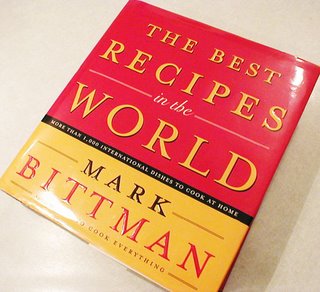
Every Monday, we'll review a food-related book here on The Grub Report. It might be a cookbook. It might be an examination of the science of cooking. It might be a chef's memoir. Today's pick falls into the first category. So, without further ado, this week's edition of Cooking the Books:
If there is one cookbook that embodies the spirit of The Grub Report, it is Mark Bittman's The Best Recipes in the World.
From the Introduction: "Home cooking has never been easier, more exciting, or filled with as much potential. ... More information about the cooking of other lands is available than ever before, and the planet becomes smaller every year."
That's our stance, too. And it is amazing to take a minute and contemplate just how easy it has become. The local chain stores carry a wide array of ingredients that just a few years ago would have necessitated a trip to Indianapolis or even farther. The Internet has become a great resource for recipes and instructions for exotic dishes to satiate nearly any craving. And now, with just a few mouse clicks, you can watch cooks from around the world take you step by step through techniques that are foreign to most American cooks, showing you that it's not really as complicated as it seems. You don't even have to crack open a cook book anymore!
But you should, for one simple reason: Bittman, a journalist by training and a connoisseur by way of years and years of curiosity and exploration, has produced one of the most easy-to-use cooking references I've ever found.
The recipes are divided up in the traditional way, by course. But for each one, there are cross-references galore. Country or region of origin. Prep time. Variations. Even whether it can be made ahead or made in 30 minutes or less.
And that's not even taking into consideration the great index in the back. There are menus that bring complementary dishes together. There is the traditional alphabetical list of recipes, but with the prep notes (make ahead, etc.) as an added bonus. There is a list recipes broken down by cuisines / region. And then there is the traditional index, with ingredients and the recipes they're used in.
So let's say you want to spend a romantic evening eating as if you're in Paris. Just flip back to the section on France in the index of recipes by cuisine. So many choices. Perhaps you'll try the Salade Nicoise, the Steak au Poivre and the Genoise for dessert. Tres bien!
Or perhaps you know the flavor you're craving, and you want to build a meal around it. Maybe you're thinking garlic. But you're not in the mood for Italian. Head to the index. Your choices will range from the Yucatan to India to Louisiana and points in between.
Maybe, though, you picked up some of that chicken that was on sale at the market, not sure exactly what you were going to do with it. Sure, you could use the same old techniques you always do. And it would be fine. It would be home-cooked. And that's great. But if you checked out the index in this cookbook, you might well find a new favorite way to cook that common bird. There are almost two full pages of ideas just waiting to be tried.
Another big plus with Bittman's book is that he has taken pains to explain things in ways nearly any American cook will understand. Exotic recipes are available enough. But instead of leaving it to the home cook to do research simply to understand the ingredient list or instructions, Bittman brings it all together.
If you truly want to expand your culinary world, this could easily be your guidebook.
And did I mention it's on the shelf at the local library? It's call number at the Marion Public Library is 641.59 BIT. And as of Monday night, it was listed as checked in. Check it out!
Originally posted to The Grub Report by Patricia Gibson on May 28, 2007 10:01 PM
Comments
At May 29, 2007 10:45 PM, James Cramer said...
In case you want to buy the book the ISBN number is 9780767906722. The book lists for $29.95 but is available online for around $20.00.
Bittman's minimalist style of describing food preparation makes the book an easy read. However, his earlier book "How to Cook Everything" is better for those just beginning their journey into cooking and there are even better books for those with a desire for more exotic explorations. Overall I would give it a 6 out of 10.
At May 30, 2007 12:12 AM, Patricia Gibson said... James:
Would you mind passing on some suggestions? I'm always looking for new books to peruse.
At May 30, 2007 8:59 PM, James Cramer said... Tricia,
Call me Jim. James is just how I sign things and it gives me a quick clue when somebody calls the house if they really know me or not.
My suggested reading list would start with some oldies but goodies. "The New All Purpose Joy of Cooking", this is the revised edition of the classic; "The Encyclopedia of Creative Cooking"; "Easy Cooking For Today";
"Easy Cooking For Today, volume II"; "All Around The World Cookbook"; "Betty Crocker's New Cookbook, (Everything You Need to Know to Cook)"
I like looking at new cookbooks and sometimes buying one or two. However, I get my best stuff at auctions. I can get a bunch of old (new to me) cookbooks at one time with hand written notes and suggested substitutions. If I am lucky there are even some clippings and note cards stuck inside.
While I am making suggestions I think it would be nice if you and Steve wrote about some of the utensils of cooking.
Let me know if you want to borrow anything. I don't have a cup of sugar but I do have Splenda. (Since I am diabetic.)
Labels: food, grubreport
>>> READ MORE ... you know you want to.
posted by Tricia at
|
 

|
|
![]()
![]()
























